SIDNEY SHAMED
Students accuse college of 'wilfully' neglecting the needs of disabled students


● Student trapped in supervision room as ramp was too steep
● Broken accessible door caused dislocated shoulder


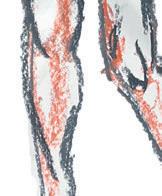

● Wheelchair accessible lift broken for three years
● Disabled students unable to access JCR, computer room, or upper library
Bethan Moss and Bella Shorrock
Deputy
News Editors
Multiple sources at Sidney Sussex have alleged that the college is in breach of the Equality Act on several counts regarding its treatment of disabled students, a Varsity investigation can reveal.
We interviewed disabled students at Sidney and their peers, who say that they have complained about the attitude and inaction of the college, but claim that “nothing has been done” to the point that Sidney are “willfully negligent”. Varsity has seen documentary evidence of these complaints from multiple sources.
e Great Gate, on Sidney Street, is inaccessible for physically disabled students, so they have to enter at the back of college — yet the back gate is frequently broken. One disabled student told Varsity that as a result, they had to go to hospital after dislocating their shoulder trying to open the heavy Great Gate. ey complained to the college, but Sidney claimed that the gate cannot be made more accessible for historical reasons.
Poor accessibility also a ects students visiting the college, socially or for supervisions. One wheelchair-using student was stuck in a supervision room for at least 30 minutes, after a ramp provided by college was taken away and used elsewhere. e student’s supo partner went to inform the porters and was told that only one ramp was available.
After several minutes of discussion, they agreed to come and assist the student.
Varsity understands that the porters suggested lifting and carrying the wheelchair out of the room — but this was “entirely unfeasible”, “due to its size, weight and intricacies”. e student told us that “the whole experience was appalling to witness”, claiming it proved college provisions for disabled students are “utterly insu cient”.
For visitors, there are just three disabled toilets in college: one is card access only and students can’t enter, one is accessible only by going to get a key from porters, and the only other disabled toilet is in the bar, which only Sidney students can get into. ere is also a shortage of accessible accommodation in the college; there are only three bedrooms that are adapted for wheelchair users. Two of these rooms are accessible only by lift — a lift which has been broken for three years. Within this time it’s worked occasionally; estimates vary from ten minutes to two weeks for how long functionality has lasted.
e broken lift means students unable to use stairs can’t access the upper oors of the library or the computer room. By not a ording disabled students access to the “bene t, facility or service” of browsing books and using college computers, it has been alleged that Sidney is in breach of the Equality Act. e JCR is also not accessible by wheelchair.
Continued on page 3 ▶



We have to recognise ChatGPT says pro-VC
Olsson

 Senior News Editor
Senior News Editor
e pro-vice-chancellor for education has said in an interview with Varsity that bans on AI software like ChatGPT are not “sensible”, explaining that “we have to recognise that this is a new tool that is available”.
Bhaskar Vira, who assumed the role in October, told Varsity: “I’m of the opinion that we have to recognise that [AI] is a tool people will use but then adapt our learning, teaching and examination processes so that we can continue to have integrity while recognising the use of the tool”.




As anxieties around AI-assisted plagiarism envelop the academic world, Vira’s comments on ChatGPT mark a departure from the recently adopted policies of other educational establishments. e New York City department of education has notably banned all use of the technology in its schools.
A spokesperson for the department said the ban was introduced in light of “concerns about negative impacts on student learning, and concerns regarding the safety and accuracy of contents”.
Referencing this development in the U.S., Vira told Varsity: “I don’t think that’s sensible because these are tools that are out there, that people are going to be adapting to and using.”




As pro-vice chancellor for education, Vira assumes overall responsibility for the University’s educational provision, devising and implementing Cambridge’s education policy.
Vira’s stance on ChatGPT is shared by others in the academic eld. Dr Peter Van der Putten, professor of AI at Leiden University, told Sky News: “It’s there, just how like Google is there...You can write it into your policies for preventing plagiarism, but it’s a reality that the tool exists”.
Released in November by the tech company OpenAI, ChatGPT is an interactive chatbot which uses AI technology to generate text in seconds. It has surprised many with its ability to create uent and coherent prose in response to a range of user generated prompts.






Similar concerns have been raised in academia. Asked about how the University would detect AI generated text in work submitted for assessment, Vira said: “I don’t think we will ever stay ahead because it will become like an arms race, I think the AI will evolve quickly and will keep trying to evolve to avoid detection to technologies”.
However, Vira is careful to sound alarmist. He downplays the often lauded potential of ChatGPT. During his interview with Varsity, the pro-vice chancellor referenced an article in e Guardian, in which John Naughton argues text generating software, like ChatGPT, will eventually become “as mundane as Excel”.


‘It's sad that this had to happen' Student control under threat at Clare Cellars
News Page 3 ▶
Students are entitled to expect more from us Pro VC discusses mental health and Cambridge workload
News Page 4 ▶
Erik
Cambridge joins in on national strike News Page 6▶
'Walkout Wednesday'
Page 19▶ Spilling the tea on the UL Tea Room Page 20▶ FREE Take a copy
a life model eatre round up Page 30▶ More stories inside ▶ e Independent Student Newspaper since 1947 No.909 Friday 3rd February 2023 varsity.co.uk
'I had this realisation that my body is not a weapon':
being
trans and
“Cambridge was a joy. Tediously. People reading books in a posh place. It was my fantasy. I loved it. I miss it still.” - Zadie Smith

editors Meg Byrom & Famke VeenstraAshmore editor@varsity.co.uk
deputy editors Esme Kenney & Hugh Jones deputyeditor@varsity.co.uk
vulture editors Hannah Gillott & Daniel Hilton magazine@varsity.co.uk
news Michael Hennessey & Erik Olsson (Senior), Bella Shorrock, Eric Williams, Caredig ap omas (Deputy), Bethan Moss (Investigations lead) news@varsity. co.uk
features Taneesha Datta & Harry Hult features@varsity.co.uk
comment Jack Rennie & Maia Livne opinion@varsity.co.uk
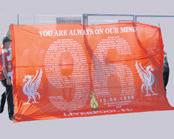




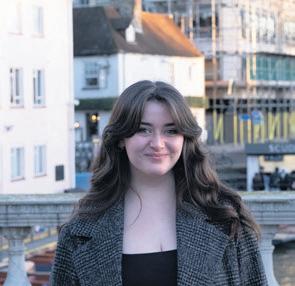

interviews Aoife O’Driscoll & Chris Patel interviews@varsity.co.uk
science Suchir Sahlan & Tom Malloch science@varsity.co.uk


sport Joshua Korber-Ho man & Abigail Hastie sport@varsity.co.uk
lifestyle Esther Arthurson & Alice Mainwood lifestyle@varsity.co.uk
arts Emily Lawson-Todd & Leo Kang arts@varsity.co.uk
fashion Isabel Dempsey & Eden Keilyurstain fashion@varsity.co.uk
film & tv Kezia Kurtz & Daisy O’Connor lmandtv@varsity.co.uk
music Georgie Atkinson & Alex Brian music@varsity.co.uk
theatre Alex Parnham-Cope & eo Chen theatre@varsity.co.uk
Head of media Minsung Son
chief sub-editor Jane Usher subeditor@varsity.co.uk


associate editors Lotte Brundle, Emaan Ullah & Bethan Moss associate@ varsity.co.uk
business manager Mark Curtis business@varsity.co.uk


varsoc president Fergal Je reys president@varsity.co.uk
varsity board Dr Michael Franklin (Chairman), Prof Peter Robinson, Dr Tim Harris, Michael Derringer, Mark Curtis (Company Secretary), Alan Bookbinder, Elizabeth Howcroft, Fergal Je reys, Lotte Brundle & Nick Bartlett (Directors)
“83878 spoons”

February
be the shortest month, but at Cambridge, we’ve got strength in numbers

February might be the shortest month, but at Cambridge, we have strength in numbers. e stories covered in this edition, from the start of eighteen days of strikes, to the many students speaking out about accessibility, demonstrate the importance of communal action in empowering individuals. As we concluded last edition, life here can be isolating, but if we give each other the time of day, we can learn new things, refashion our own perspectives, and generally make the most of this eeting month as it slips through our ngers.
Four weeks can easily ash by, and it’s easy to trap ourselves in our own worlds, undisturbed and unbothered. But student journalism gives us an opportunity to glance into other peoples’ lives, expanding the limited scope of the twenty-eight days we each have as individuals. We might imagine ourselves in dialogue with the new Pro-Vice-Chancellor, or reassess our own personal preferences when it comes to Sidgwick co eehouse staples. For
the rst time, we might spend time re ecting on our previously unexplainable desire to steal—or contemplate our own favourite charity-shop haunts.
It can introduce us to people and their stories that we might not have otherwise have actively sought out. Amidst the unavoidable chaos of our lectures, seminars, and reading, we can hardly be blamed. It all works to reassure us that we are one of many, anticipating its end whilst desperately trying to remain in the moment.
ere’s no time-limit on certain stories, and it is often ones which cover things we can all relate to which prove most resonant. And though breaking news remains an important (and exciting) aspect of our lives, there’s strength found in taking each day as it comes, and each story as we read it. Some will stay with us forever, and others will prove as vanishing as this month. We hope, however, that whatever articles strike your fancy—you’ll make the most of them.
“a

“I could not possibly say”

2 Friday 3rd February 2023
© VARSITY PUBLICATIONS LTD, 2022. All rights reserved. No part of this publication may be reproduced, stored in a retrieval system or transmitted in any form or by any means electronic, mechanical photocopying, recording or otherwise without prior permission of the publisher. Varsity, 16 Mill Lane, Cambridge CB2 1RX. Telephone 01223 337575. Varsity is published by Varsity Publications Ltd. Varsity Publications also publishes e Mays Printed at Ili e Print Cambridge – Winship Road, Milton, Cambridge CB24 6PP on 42.5gsm newsprint. Registered as a newspaper at the Post O ce. ISSN 1758-4442 Inside Varsity investigates students’ experiences 9 NEWS Hardship funding at di erent colleges From crockery to candlesticks, we can’t seem to resist the allure of crime COMMENT Why Cantabs love to steal We interview the ex-speaker about bullying, bias and Brexit INTERVIEWS Getting things in order with John Bercow What is it like modelling as a transwoman for life drawing in Cambridge? ARTS Being a trans life model 19 Editorial Famke Veenstra-Ashmore & Meg Byrom, Editors, Lent 2023 Georgie Atkinson queries the favourite tunes of the University Yacht Club MUSIC Tuning in with the yacht Club 27 SPORT Hillsborough, class, and authorities 32 What does the aftermath of Hillsborough tell us about the nation? 13 16 Interested in writing for Varsity? Join our writers’ group on Facebook! “wooden bench from Sidney Sussex” “my entire glassware collection” “the matriculation photo from an Oxford college JCR on a sports trip” “so many plates” “Joseph Du y’s heart”
“laminated signs” What have you stolen from a Cambridge College?
sign
bar”
from Sidney Sussex
to give an answer? Follow us on Instagram @varsitycambridge
“a plateful of mince pies” Want
might
Editorial Week 3
Students have claimed that no wheelchair-using student has matriculated at Sidney for at least three years – and it’s likely that if one were to be accepted that they would want to change colleges, or live o site given the lack of adapted accommodation. If Sidney were to choose not to o er students places due to physical disability, or to pool physically disabled students who apply on the grounds of their disability, this would be in breach of the Equality act.
Students tell us that other “tutorial rooms” allocated based on access needs are not suitable for many physically disabled students due to size and lack of adapted bathrooms, and that the process for applying to accessible accommodation is “bureaucratic, confusing and oputting”. An email was sent to students last month which said that the College would only consider requests supported by an SSD (Student Support Document), which can only be issued by the ADRC. When disabled students come to Cambridge, there is no requirement for them to disclose their disability to the University or the ADRC, or to get an SSD. Varsity understands that other colleges allocate accessible rooms without requiring this document. While the JCR later sent an email clarifying that an SSD is not the only route to getting an accessible room, students we spoke to said that the initial email is a sign of a culture that discourages students to ask for their needs.
One student claimed: “ e attitude of senior sta has been: ‘this is the way I want to do it. And if you’re discriminated against because of that, that’s not my problem’”.
In at least two cases, Varsity understands that disabled students have been allocated unsuitable rooms, but have been able to nd students in more suitable rooms willing to swap with them. e College has refused to approve such
Student control under threat at Clare Cellars
 Amelia Platt News correspondent
Amelia Platt News correspondent
Clare College is advertising for the role of external bar supervisor at Clare Cellars, raising concerns among students who work there.

Varsity has spoken to two student bar workers at the Cellars who claim that the proposed change threatens the studentrun nature of the bar.
e bar committee was not consulted prior to the college’s decision to advertise for an external bar supervisor, and were told just last week that the process was underway.
One student bar worker, who wished to remain anonymous, said that the decision came as a surprise to all bar workers.
e student told Varsity: “ ere have been problems before but we all thought that the running was going smoothly and therefore did not justify the employment of a supervisor.”
ey added: “ e whole point of having student workers and a committee
is so that they can have a collaborative role with the college to make sure the bar runs smoothly. Not involving us in such decisions undermines this entirely.”
e role of the external bar supervisor is advertised online, with the duties described as managing the student bar workers, organising rotas, ordering stock and managing event bookings.
One student-bar worker said that such a role “would result in fewer committee roles and therefore inevitably less student control in the bar”.
Another added: “ e thing is that we are students but also adults. Many of us have hospitality jobs at home and are trusted with certain responsibilities.”
“ e fact of having an external person present in the bar feels to us quite patronising. We know how to do our jobs. is is not just a hobby, we are getting paid for it. It feels like we are not really being treated as adults.”
ey added: “It’s important to emphasise how central the bar is to the social life and culture of Clare.
It’s not just a bar where people buy
swaps, sometimes without giving reasons. One student told Varsity that “the onus is on disabled students to ght for their basic rights”.
Another student said that it feels like the College is “going above and beyond to deny disabled students accessible rooms”, claiming that there’s “an active animosity towards disabled students’ needs”.
Chapter 2 of the Equality Act 2010, concerning further and higher education, states that an institution must not discriminate against a person “in the arrangements it makes for deciding who is o ered admission as a student” or “by not admitting the person as a student”.
e Equality Act also says that institutions cannot discriminate against disabled students “by not a ording the student access to a bene t, facility or service; by excluding the student; or by subjecting the student to any other detriment”.
Institutions also must not victimise disabled students with “the terms on which it o ers to admit the person as a student; by not admitting the person as a student” or “by not a ording the student access to a bene t, facility or service”.
Other areas of the college that are “ofcially accessible” can only be accessed by ramps acquired from the porters. Varsity understands that the scarcity of such ramps means that it takes students who need them signi cantly longer than their peers to get anywhere in college. One student told us, “it’s not accessible for students to have to go to the porters for a ramp every time they want to enter a building — it takes away your independence.”
Some students claim that college’s advice about access to supervision rooms and other buildings is unclear, citing “Invisible ramps, that don’t work and aren’t safe” — others told us that they believe the permanent ramp, by the Mong Hall,
may be illegally steep.
When students raised concerns with college sta , experiences varied. While some tutors and directors of studies were helpful, students have alleged others, including more senior sta , “just seem not to care”.
Students claimed that sta are “insensitive” and seem to lack training in dealing with the needs of physically disabled students. One student claimed that they were not made aware of available funding for private therapy until after they intermitted, another that their tutor didn’t seem to know what double time was at all.
Another student alleged that the way college deals with disabled students is “dangerous” and “puts people o getting help”. ey allege that the attitude of sta means that “If someone’s in a state of crisis, even when it could be life threatening, the thing that everyone says rst, is ‘don’t tell college’… e consequences of asking for help can make it not worth it, and I’m really worried that it’ll cause a major incident…I just want something to change”
All of these issues have been raised by students to the college previously, but students told us: “nothing has been done” to the point where college are being “wilfully negligent” — “situations they could have made better, they’ve actively made worse”.
“One day we’ll look back on this and be appalled” that disabled students were ever treated like this.
e JCR responded to the allegations and told Varsity: “ e JCR cares deeply about disability access, and has raised many of these issues to the college on multiple occasions. We hope this article provides further encouragement to move forward swiftly on this matter. To any students struggling with accessibility needs –we are here for you, please do continue to reach out to us for any advice or support”. Sidney Sussex College did not respond to Varsity’s request for comment.
drinks. It has real importance to the college, and this decision feels like it is trying to stop that.”
One student acknowledged that an external bar supervisor may be needed in terms of organisation and safety saying: “they would provide continuity which is not provided as the bar committee changes every year” but the committee “has shown that they are very well organised”.
According to one student, the bar committee has met with college leadership to express concerns over the proposed changes. In the meeting, it was concluded that the Bar Supervisor job is necessary for reasons of continuity, and for ensuring the licence agreement is adhered to. However, the college agreed that the committee will have a role in selecting the successful candidate, and will be able to communicate with the college regarding things that they want to stay the same in Cellars.
e student added: “It’s good that the college is being responsive to our concerns, but still sad that this has had to happen.”
Friday 3rd February 2023 3
Story continued from front page ▶
▲ ‘It has real importance to the college’: Clare Cellars packed with relaxed students (ALEX PARNHAM-COPE)
▲ Some areas of Sidney Sussex that are ‘o cially accessible’ can only be accessed by ramps acquired from the Porters’ Lodge (HANNAH GILLOTT)
News
Students are entitled to expect more Students are entitled to expect more
Erik Olsson Senior News Editor
Hands in pocket and legs crossed, Bhaskar Vira leans against the window and smiles for the photographer. he provice-chancellor for education is dressed smartly, wearing a light navy suit jacket and a striped shirt. “I’ve got to be in West hub for 10,” he informs me, now pushing back comfortably into his chair. It’s early Monday morning and we’re sitting in a conference room inside the Old School’s building. Nestled between Senate House and Clare College, the unassuming building is home to the University’s central operations. Copies of Varsity scatter the desks of a bull pen downstairs.
On paper, Professor Vira’s name precedes a parade of lofty academic titles. He is certainly an accomplished man. Cambridge lecturer since 1998, fellow at Fitzwilliam soon after, and head of the Geography department up until recently. He has, by his own admission, “done almost every job in the University”.
Now pro-vice chancellor for education, Vira is keen to explain what the role actually entails. “Anything to do with the educational provision in the University
comes under my remit: that’s undergraduates and postgraduates,” he says.
On today’s agenda: the University’s student mental health plan for the next three years. he plan is ambitious. Recognising that Cambridge can be “challenging” for some, it emphasises a “proactive and preventative approach”, capturing the urgency of the crisis. Yielding occasionally to alliterative jargon like “Suicide Safer”, the plan is nonetheless a step in the right direction, allocating greater funding to staf training, mental health services, and out of hours support.
Prefacing its commitment to “listening closely to what students are telling us”, the report says the University is “distinctively placed as a collegiate institution” to deliver hands-on support. Do Cambridge students expect too much from the University? “I do, and I think they are entitled to expect more”.

Even the SU have said its proposals “will hugely beneit students”, noting that “it’s great to see extensive time and money being put into student wellbeing”. It’s clear the University have listened. So why now?
“We all know that the last three or four years have been particularly challenging for young people,” Vira says, though
he’s notably reluctant to say the mental health of Cambridge students is in crisis. “People have already been talking about a real crisis in mental health, I think that’s the terminology that’s used,” he says. “We do know that this is widely reported."
He points to the pandemic, and the efects it has had on a whole generation of Cambridge students: “the pandemic has exacerbated [the crisis]”. But he also attributed mental health concerns in Cambridge to the “genuine phenomenon…of climate anxiety”. “You don’t need to be someone who avidly reads the newspapers to be worried about the world,” he explains. While certainly of concern, it’s diicult to take this comment seriously from a igurehead of an institution with strong links to the oil industry. Besides, the intense Cambridge term doesn’t often leave much time for existential angst.
Vira singles out the counselling service’s turnaround times as a key achievement of the University. All students who were referred to the University’s counselling service (UCS) in Michaelmas were ofered an appointment within three working days, meeting all the targets set by the University in October. Pro-

4 Friday 3rd February 2023 News
▲ Pro-vice-chancellor for education Bhaskar Vira in conversation with Erik Olsson (TOBIA NAVA)
from us, says pro VC from us, says pro VC

gress certainly, but, as the plan states, “we know we have a long way to go”. Moreover, it’s still unclear how long students have to wait for their second appointment.
Re ecting what the acting vice-chancellor told Varsity last term, the plan also identi es - albeit eetingly - workload as a potential area of concern. “Is Cambridge too hard,” I ask Vira. He hesitates slightly. “So lets start from the beginning,” he says. “We take students who are already selfachievers. Our average intake is higher than our published requirement…they are very self-motivated to continue at that high level. Cambridge continues to match that expectation”.
He doesn’t dismiss workload concerns completely, however. “I think there are questions around the demands we make of you - which is a sort of workload question”. He puts this down to the competitive instinct of Cambridge students.




But doesn’t the University create that pressure? e ranking system not only encourages but facilitates a culture of comparison. “It does and it doesn’t,” says Vira. “At least these days it’s not public knowledge…I see [competition] manifesting much earlier than the exam season… that sense of peer competition is wider
than just the ranking system”.
Vira seems to suggest that it’s not so much the workload which is the issue, but the organisation of work. “So in many subjects, certainly in Michaelmas term, it’s not unfamiliar for people not to have a huge amount of deadlines in the rst three or four weeks. And then all their deadlines bunch in weeks ve and six of term”.
“I did the tripos 30 years ago and most of what I learnt in the tripos is still in the curriculum, and they have also added on much more,” he says. “I wouldn’t be surprised if we are doing too much”.
Assessment too may be subject to change. Vira says he’s interested in investigating alternative modes of assessment so that end of year exams aren’t the sole indicator of performance.
Mental health is clearly a sensitive issue for the University, and Vira is typically measured. An economist by training, he’s always forensic in his analysis and careful not to dismiss the concerns of any interested parties. But, in some cases, his occasional impartiality risks translating as ambivalence, particularly as this - at least anecdotally - is a concern for so many.
What is the University's new mental health plan?
Michael Hennessey Senior News Editor
Last year an external reviewer branded the mental health services at Cambridge as “ine ective”, “untargeted” and “unsustainable”. A review said that there were “wide variations” of support levels between colleges and expressed concerns that “senior tutors, tutors and other college sta with a welfare role are overstretched and are dealing with often signi cant issues."
One student told the BBC that they were left with the impression that “as far as college were concerned, if I were to die they wanted it to be not on their property."
In response to this, the University have set out a new ‘Student Mental Health and Wellbeing Plan 2022-2025’ which aims to “develop a whole-institution approach to student mental health and wellbeing."


e new plan acknowledges that “life for some at Cambridge can be challenging” but highlights that the new plan aims to create “a genuinely supportive and inclusive place to live and study."
e new plan pledges swifter access to counselling and increased capacity
within the University’s sexual harassment and violence support services. e plan also promises to educate sta and students in leadership positions about the importance of mental health and “rationalise governance arrangements across college Cambridge."
e plan also vows that the University will set up a University student wellbeing team “with an emphasis on prevention and early intervention”. Crucially, the new mental health plan suggests that workload may be addressed in the future. e plan says the University will “continually seek input and feedback from students to understand which aspects of their academic life and student experience have the greatest impact on their wellbeing and mental health and take action to address reported concerns (such as workload).”
e University has acknowledged that they have a “long way to go” with the new mental health plan. However, the University has also asked for “the help of everyone across the University.” e Student Union have backed the proposals made in the plan saying that they will “hugely bene t students”, and congratulated the University for “extensive time and money being put into student wellbeing”.
News
‘Walkout Wednesday’: Cambridge joins national day of strikes
Why are sta on strike?
Eric Williams
As two months of major strike disruption begins, what are the disputes, and what do students need to know?
What’s happening?
Starting on Wednesday (01/02), eighteen days of strikes are set to take place over the next two months, in what has been called the largest action in the history of UK Higher Education.



Cambridge University will join more than 70,000 sta at universities across the UK striking over pay, conditions and pensions disputes, with action a ecting over 2.5 million students.
What are the strikes about?
e UCU is locked in a pay and conditions dispute with the Universities and Colleges Employers Association (UCEA), and a pensions dispute with Universities UK (UUK).
e Union has said disruption is ‘entirely the responsibility of university bosses who have refused to make sta fair o ers’.
Why are academics striking over pay and conditions?
e UCU is demanding a pay rise 2% above in ation (RPI).
e University and Colleges Employers Association (UCEA) made a slight improvement on previous pay o ers last week, with a 5% package.
late last year, estimations by Cambridge University’s actuary advisors suggested reforms were going ahead despite the fact that the USS pension scheme was in surplus, (and would be even if bene ts were restored) - ndings which later appeared to be supported by USS nancial monitoring data.
e UCU is demanding that bene ts be restored to 2021 levels, and for universities to raise their contributions to amounts that they have been shown to be able to a ord.
Strikes have happened beforewhat makes these di erent?
is is the sixth year of strike action at the University of Cambridge, with the series of disputes beginning in February 2018 over pension cuts. Predating the majority of the current student body’s arrival in Cambridge, academics were striking against increased pension contributions, and Cambridge saw occupations of the Old Schools administrative building by sympathetic campaigners.
Eric Williams
Deputy News Editor
ousands marched on Wednesday (01/02), in what some have described as ‘the biggest strike march Cambridge has ever seen’.
It marked the rst of eighteen days of planned strikes that will hit Cambridge in February and March during
A crowd estimated to be ve thousand strong rallied on Parker’s Piece before marching to the city centre. As a result of the national mandate through aggregated ballots, striking sta from Cambridge University, Anglia Ruskin and the Open University joined forces. Striking UCU members were also joined by members of the National Education Union (NEU), Cambridge & District Trades Union Council, Unison, the Public and Commercial Services Union (PCU), Unite and ASLEF. Postgrads from the ‘Justice4CollegeSupervisors’ campaign were also present, as well as sympathetic students and members of
Speeches at the rally discussed the cost of living crisis, cooperative action between di erent unions and cuts to
One striking school teacher told Varsity: “Right now, we’re teaching in classrooms that aren’t t for purpose. We’ve got no money for support sta , no money for resources. I’m not just out here because we can’t go on with current take-home pay, I’m also out here because we need better learning conditions for our children - this action is about giving them the education that
Discussing the UCEA’s most recent
pay o er, one striking academic told Varsity: “I think it’s despicable, absolutely despicable. Our pay has been hit over and over again over the last ten years. We’re at breaking point.” Meanwhile another striking member
said: “It’s de nitely far too low, but I actually think the o er is a sign of our strength-I’mnotsurewe’dhaveachieved something
past.”
Picket lines were staged at Downing Street, the Education Faculty, Sidgwick Site, Senate House and West Cambridge. e action took place as half a million people went on strike across the country, with teachers, civil servants, Border Force sta and train drivers withholding labour, in what has been branded the UK’s largest day of industrial action in over a decade.
Action also coincided with the TUC’s national ‘protect the right to strike’ day, protesting against the governments’ new bill that aims to guarantee minimum service levels from key workers going on strike.
Dean of Emmanuel College Jeremy Caddick attended the protest, telling Varsity: “I’m really worried about the Draconian legislation the government are introducing to limit the right to strike. I think they don’t realize just what they’ve started - unions are getting together and momentum is building. is problem is not one that’s just going to go away.”
In an interview with Varsity, President of Cambridge UCU Michael Abberton said: “None of us want to go on strike, eighteen days is a heck of lot of money to lose, not to mention our members’ concerns about the e ect on students. However, we have had no choice, as the o ers that we have had, like that from the UCEA, are nowhere near being reasonable or realistic in relation to what our members really need.”
●For the full interviews with protestors, go to @Varsitycambridge on Instagram
However, with in ation (RPI) at 13.4%, the UCU have criticised o ers as too small to address the cost of living crisis, and as another real-terms pay cut after a decade of low pay.
Why are academics striking over pensions?
In April 2022, the employers representative Universities UK (UUK) implemented major reforms to pensions, which are provided by the Universities Superannuation Scheme (USS). e USS is the UK’s largest private pension scheme, holding the retirement savings of 470,000 university and college workers. According to the UCU, the new policies wiped 35% o sta ’s future retirement income.
Reforms were justi ed on the grounds of March 2020 evaluations that placed the scheme in a de cit between £14.9bn and £17.9bn, which fuelled claims that pensions were unsustainable. However,
However, this time the UCU has particularly strong leverage, because it secured a national strike mandate in October last year, when members across the country voted to strike in an aggregated ballot. is was the rst time an education union, and third time a trade union, had managed to win a nationally aggregated ballot since the 2016 Trade Union Act tightened laws on industrial action.
When will the strikes end, and could impacts on students go beyond the 18 days of strikes?
Action will end if a resolution for the disputes is agreed upon. If that doesn’t happen, action could extend past the end of March, if the UCU chooses, and successfully manages, to reballot its members.
If the dispute is not resolved, the UCU has warned that the sector will face ongoing action throughout 2023, with promises to reballot and renew the national strike mandate.
A key part of the union’s leverage is the threat of a ‘marking and assessment boycott’ from April if the employers representatives do not make a satisfactory o er - with any marking boycott in the summer likely to cause major disruption to exams.
News
▼DanielHil ton f or V a r s i t y 6 Friday 3rd February 2023
▼ e protest started at Parkers Piece, before marching to the city centre (DANIEL HILTON)
‘Seriously concerned’: Breakaway JCRs rebel against SU voting system
Suchir Salhan News correspondent
A breakaway group of JCRs, composed of Trinity, King’s, Jesus, Queens’, Robinson and Lucy Cavendish, are “seriously concerned” by recent reports concerning a data “breach” at Cambridge’s Student Union, which led to students being “outed without even knowing”.
The JCRs have formed the Cambridge Online Voting Consortium to set up an open-source election system as an alternative to the SU’s ‘outsourced’ election system, electing Jesus College JCR as chair of the consortium last week.
Jesus College JCR President Nicole Ling Yan Lee and other representatives from the consortium told Varsity that they were “shocked to discover that a list of LGBTQ+ students existed on the platform at all”, following Varsity’s report on data issues on the SU’s voting system. The SU is now conducting a student-led inquiry into the data breaches to determine why “the incident occured and was not resolved for over nine months after first being raised”.
Representatives from the consortium told Varsity that the data breaches had been a “foreseeable outcome”, as the SU chose to outsource the development of a “clunky, closed source, obscure piece of voting software”.
The SU had originally used a secure ‘basic online ballot’ system (BOB) to cast over 300,000 votes in university elections since 2005, where votes were not stored with CSRids and students could transparently verify election results. However, there were problems with the old voting system, as the presence of a list of students who voted in an LGBT+ campaign election could still potentially out LGBTQ+ students.
Varsity understands that when this secure system was retired by the SU in September 2021, concerns were raised that the new system “could not provide the anonymity and verifiability” of the old system. Representatives from the concerned JCRs have said that despite raising these security concerns “the SU decided to proceed with the system switch”.

Earlier this year Varsity reported that
of phosphate in the Cam
Finley Brighton
News correspondent
Local environmentalists have found that phosphate levels in parts of the River Cam are 70 times higher than the acceptable amount, according to laboratory tests of water samples.

Concerns were initially raised by district councillor Richard Pavitt, who has been testing the river water for the past two years.
Pavitt’s findings were then validated by Cam Valley Forum, a Cambridgebased charity which was set up to gain a better understanding of contamination in the Cam and determine sources of waste.
Phosphate is found in sewage and household waste and removes oxygen from water. The high levels of phosphate in the River Cam is distressing news for Cambridge’s aspiring open water swimming community.
Phosphate has been emitted into the river from sewage water treatment centres in Great Chesterford, Newport and Quendon. Councillor Pavitt claimed that this is the result of “serious neglect” by Anglian Water and the Environment Agency.
When asked about the findings a spokesperson for Anglian Water told Varsity that sewage treatment works in Quendon and Newport will be “upgrad-
chair of the SU student council Fergus Kirman and Sam Carling also claimed to have faced obstacles from the SU when they raised the issue with the data breach.
In response to the difficulty of using this new system, the consortium developed CamVote last year - an open source voting system which promised “verifiability, anonymity and instant-counts”. They have promised that this system, unlike the SU system, would never store data about student self identities. Representatives from the consortium told Varsity that “data which doesn’t exist can’t be breached”.
They argue that CamVote offers “selfgovernance by and for JCRs and MCRs, without alternative missions or goals which might crop up in a larger organisation”.
“Rather than trusting the SU and their contractors to correctly count an election and have a secure system, the goal of CamVote is to make it so that you don’t have to trust anyone - if you suspect election tampering, you can check for yourself (and we are happy to show people how to do this).”
The spokesperson for the consortium continued: “If we want our representatives to be taken seriously, by students
and by the University and colleges, there needs to be trust in the way they were elected. Delays to results, not being able to audit results, and confusing voting and election administration all degrade the quality of democracy.”
Last year, members of the Student Council raised concerns about the voting system and proposed to return to the BOB system. The trustees decided not to ditch the new voting system despite concerns over its usability and transparency, citing time constraints before the Lent elections and a desire to reform the existing system.
ed to reduce phosphate concentrations entering the River Cam by the end of 2024” as part of the company’s £800m environmental investment programme.
However, this is not the first time Anglian Water has faced criticism for their environmental record. The Environmental Agency recently issued a fine to Anglian Water of £560,170 for a sewage leak in 2017 that killed 5,000 fish. 6 million litres of sewage was discharged into River Great Ouse for 23 hours, which is enough to fill two Olympic size swimming pools.
In response to their recent prosecution for the sewage leak, a spokesperson for Anglian Water told Varsity: “We take our duty of care to the environment incredibly seriously and deeply regret any negative impact when things go wrong.”
They reasserted their pledge to “improve further and progress towards achieving our zero pollutions goal.”
News
‘Serious neglect’ has caused high levels
Friday 3rd February 2023 7
▲ The Cam was found to be 40% sewage effluent in an investigation last year (REBECCA TYSON)
Girton College therapy dog passes away
Darwin Kershenbaum, the Girton College therapy dog, passed away on ursday, after su ering a stroke last week. Darwin had served as the College’s therapy dog since 2018. Darwin made one last appearance on Saturday (29/01), with over 50 students turning out to see him before his retirement. After his stroke, Darwin was wheelcharbound before later passing away.
Synagogue rebuild rejected by council
Plans to rebuild the synagogue on ompsons Lane have been rejected by councillors. e application was submitted by the trustees of the Cambridge University Jewish Society due to the current space being no longer t for purpose. Despite council planning o cers supporting the proposal, councillors rejected the development, citing concerns about the larger building blocking light to nearby homes.
Gira es set to invade Cambridge
A large heard of gira e sculptures are set to descend on Cambridge in March 2024 as part of an art installation by the charity Break. e art installation, a sequel to the Cows about Cambridge trail in 2021, will feature 40 gira es decorated by artists and sponsored by local businesses. e proceeds will support Break’s charitable aims of supporting young people in care in East Anglia.
Addie’s expansion to open in summer
ree new surgical theatres at the Cambridge University Hospitals are on track to open this summer. e new theatres are expected to reduce waiting times for routine orthopaedic surgeries, and provide an additional 40 beds for those receiving surgery. It is expected to increase capacity by 20%. e hub is part of a scheme to provide 50 new surgical hubs across England.
University watch
Eric Williams brings you the top student stories from the other place(s)
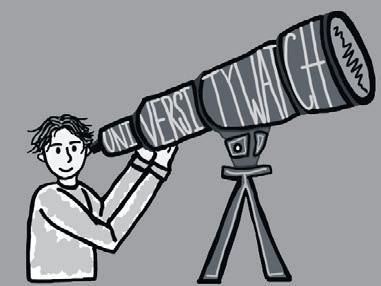
Oxford dons sue over ‘Uberisation’ of teaching
A landmark 2021 supreme court ruling against Uber’s employment practices is now being used to sue Oxford University for employing academics as gig economy workers.
e two lecturers suing the University were employed on xed-term “ personal services contracts for 15 years before the university failed to renew them in 2022. e pair have also claimed “unfair dismissal”, arguing that previous involvement in trade union activism contributed to the decision not to renew their contracts.
WE ALSO STOCK A WIDE RANGE OF CAMBRIDGE RELATED GIFTS AND SOUVENIRS

Durham rent strike
Durham saw protests on Saturday, against what student newspaper Palatinate has called the “biggest ever increase in accommodation prices” In ation including housing costs (CPIH) was 9.2% in December, but Durham’s student accommodation fees have risen 10.3%. As a result, standard catered rooms with shared bathrooms have reached £234.77 per week. Students’ demands include a reversal of accommodation fee increases and price caps calculated relative to maintenance loans.
High court to hear against UCL fees
e High Court is set to hear a group litigation order against University College London (UCL), as the rst of a series of cases aiming to sue UK universities for failing to nancially compensate students for recent strike and COVID-19 related education disruption. is is the rst part of broader planned legal action by Student Group Claim, which has collected more than 75,000 signatures from students at 18 universities.
Lawyers have argued that the cancellation of in-person tuition amounts to a breach of contract, entitling them to go to court.
If successful, students could receive an average compensation of £5,000. UCL will argue that students should go through internal university procedures.
ALL BOOKS FOR HOLDERS OF CAMBRIDGE UNIVERSITY AND CAMCARDS SIMPLY PRESENT YOUR CARD IN STORE 20% OFF 1 Trinity Street, Cambridge CB2 1SZ 01223 333333 bookshop@cambridge.org Offer can’t be combined with other promotions
Illustration by Richard Briggs
8 Friday 3rd February 2023 News
▲ FAMKE VEENSTRA-ASHMORE
College hardship fund applications are ‘humiliating’, students say
Bethan Moss
Investigations lead
Cambridge has increased its central hardship funding by £500,000 to help students cope with the cost of living crisis, but often struggling students turn to their colleges for help irst. Varsity interviewed students about their experiences with accessing inancial help from ive diferent colleges, and found that some claimed the process was “humiliating”.
“It’s not something I’m very comfortable with, so I try to only ask when there are no other options,” one student told Varsity. “Only those sufering the most dare to reach out,” another student said. Shame was a common theme among students interviewed – experiences vary, but many have found applying for college hardship funds invasive or overly bureaucratic.
Jesus student Susan began to experience inancial diiculties in second year. His maintenance loan – which had been reduced by £6,000 – was less than rent, but his parents were in debt, and unable to support him. He told Varsity that college were initially “a bit investigative” but eventually helped him apply for their hardship fund, and deferred his college bill, which they agreed he could pay of over the course of his degree.
However, Susan claims that last year, once the member of staf who he’d made the agreement with had left Jesus, he was told to “pay of the debt [he] had to the College at once”. his amount was over £2,500 on top of his college bill. He says he was told by the new staf member that his initial agreement “no longer holds” and he would have to pay within “a few days”. Susan then had to resort
to applying for hardship directly from the University.
he experience “made things really diicult”. He told us: “It made me realise how the support was not really a system, it’s just person by person, worker by worker.”
Another undergraduate at Jesus, Shannon*, expressed other concerns to Varsity. Particularly, she claims that the cost of living outside of term time feels “largely unacknowledged”. Shannon’s parents need her to contribute towards household expenses and bills when living at home. When asking the College for support, she said she feels “ashamed to have to spell out exactly what my needs are”.
he process of applying for hardship is very of-putting, Shannon told Varsity Applicants must “ill out a six-page document” detailing “every source we may receive money from”.
Jesus’s Senior Tutor, Dr Paul Domini-
emails to all students. If anyone has any concerns about the process, I encourage them to contact me.”
Students at Murray Edwards have also had diicult experiences when trying to access hardship funding. Mia says she told her tutor that she needed support to buy groceries and other essentials in Easter 2022, and illed in the appropriate forms. Her request was approved, but the money was only received at the end of term, after “pestering”. Needing to cover debt from last academic year, she started Michaelmas 2022 with no savings, and increased rent; she’d been left with less than £100 to last all term.
Mia contacted college two days into term, and says she was forced to detail every single expense. She claims that Murray Edwards then “began to nitpick everything” and didn’t “recognise that my SFE dropped and rent rose”.
She continued: “he inancial tutor told me it would be ‘economical’ to change lease from a 29 to 36 week one to save money, even though it was more expensive — I didn’t choose a longer lease in the irst place because I couldn’t aford it”.
parents’ inancial responsibility during the breaks. When applying for hardship funding, Zara says the College asked her “very personal questions” about her family relationships, seemingly unrelated to her inancial needs. She described the process as “undigniied” and “humiliating”, saying that: “Sometimes it feels like
through”.
Caius Senior Tutor Dr Andrew Spencer said: “We endeavour to support all Caius students in hardship and treat all applications on their individual merits. As a charity we have a duty to ensure funds are shared responsibly and sometimes that involves a form of inancial disclosure.”
He continued: “We hope the majority of students are happy with the support we provide and the ways to seek support” and encouraged “anyone who is not content” to bring their concerns to him or their tutor.
you’re being told of”.
ak, told Varsity that the College “understand the impact of inancial hardship and ofer a range of support, working closely with students to support their inancial needs appropriately.”
He continued: “We have a dedicated Financial Tutor to ensure consistency and support the application process, and we explain how to apply for funds on several intranet pages and in regular
Mia was told to apply to a separate fund for medical taxis and get re-evaluated by student inance, and says it felt like college “were trying to ind a way to blame me, or to redirect me to anywhere else”. Eventually, when she forwarded her emails to tutorial, Mia was told that she could pay rent late, something which had never been given as a possibility before.
Zara told Varsity that the Murray Edwards inance tutor suggested she use her overdraft to fund her living expenses, and that they expect students to be their
Deaf students criticise ‘ridiculous’ shortcomings in accessibility
Claire Gao News correspondent
Deaf students have told Varsity of substantial administrative responsibilities, complications with lectures and signiicant impacts on mental health as a result of shortcomings in the University’s resources and disability awareness training.
First-year History student Ria Patel has described the “ridiculous” amount of administrative work necessary she has to do to get the support she needs.
According to Patel, in cases where problems arise and coordination between diferent departments is necessary for support, the responsibility is put on the student. Patel told Varsity that these issues are “time-consuming and stressful” for students.
Students have reported lecture accessibility shortcomings, with claims that supervisors and lecturers are not undergoing Deafness awareness training
when necessary. Patel told Varsity that students need support beyond relying upon the “understanding” of sympathetic supervisors.
Patel told Varsity: “here’s a lot of other stuf [staf] need to know about. Amongst others, important accessibility requirements include limited background noise, good acoustics, good talking pace and facial direction, and lecturer microphone use.”

According to ifth-year Medicine student Ashna Biju, inadequate arrangements have undermined her ability to participate in hospital brieings.
Limitations on provided services such as note-takers in lectures have also been reported. Biju said that throughout her time at Cambridge, she has tried all the diferent resources, but that resources were extremely diicult to acquire and often of bad quality.
Students who need support have criticised the service of external companies funded by the Disabled Students’ Allow-
ance (DSA). Students have told Varsity that the University’s Accessibility and Disability Resource Centre (ADRC) often has to step in.
However, even with the University’s note-takers, students have complained that notes are often inadequate. Deaf students have said this can be due to ‘remote’ note-taking from lecture recordings which can be poor quality with auto-captioning of dubious quality.
Varsity has seen an email from 23 January from a note-taker who said that they could not understand a recorded lecture at all. Disabled students have told Varsity that this issue is compounded within some faculties, such as History, that do not provide lecture recordings to all disabled students due to lecture timetabling issues.
he ADRC, Student Union’s Disabled Students’ Campaign and Faculty of History have been contacted for comment.
Students at other colleges have had more positive experiences with accessing hardship at a college level. Cleo, a student at Caius, told us that she needed money to stay in College over the break — she didn’t receive money from her parents and her home situation made it impossible for her to stay there at the time. All she had to do was ill in a form and her tutor handled everything else, speaking on her behalf in a meeting.
She said that she appreciated not having to give a sob story to “convince anyone [she] was deserving of the money”, and her tutor “was able to negotiate a 75% reduction (the full 100% was reserved for full bursary holders)”. She never had to speak to anyone but her tutor.
Other students at Caius have also had similarly positive experiences with rent reduction for personal issues but some have found, when applying for help purely on a basis of inancial reasons, that there are “many more hoops to jump
In other positive experiences with inancial help, Amy told Varsity that she appreciates how Fitz has given “inancial support without being prompted”. She says those who receive the Cambridge Bursary were automatically given a cost of living payment in Michaelmas of £350 by the college.
Amy said that the payment “mitigated the potential of inancial stress for the future”, adding that she was “very grateful”.
A spokesperson for the College said that they “recognise the impact of the cost-of-living crisis, particularly for students on ixed bursaries” and clariied that the payment had been made to all Fitz students receiving the Cambridge Bursary, and select others, with awards totalling £54,950.
hey continued: “Any Fitz student experiencing inancial hardship is encouraged to speak with their tutor, who will help identify sources of funding.”
Some names have been changed.
Murray Edwards College did not respond to a request for comment.
Friday 3rd February 2023 9
▲ Climate change activist group ‘his Is Not A Drill’ broke windows at the Department of Chemical Engineering and Biotechnology in the early hours of Sunday morning (29/01) - Read the full article on the Varsity website (ANASTASIA PERYSINAKIS)
amount that the University of Cambridge has increased its central hardship funding by
£500,000 he
News
£350 he Fitzwilliam College cost of living payment given to students who receive the Cambridge Bursary
“I feel like I'm living two
completely di erent lives”
Perspectives: faith
Reuben Baldwin
I may be a Quaker, dreading all things noisy and showy, but when I descend into central Cambridge on a Sunday I love the ringing of the bells. Pause and listen, and the ringing seems pervasive, as though, despite centuries of schism and slaughter all the churches were calling out as one.
Christianity, however, is broader than this image implies. Christianity structures our lives, but over time this faith has expanded and splintered. I am a recent convert (one year since I went to my rst Quaker meeting) and encountering this community that I now call my own has been a lesson in openness and humility. You won’t nd Christianity epitomised in one place. You’ll have to penetrate the ringing of
the bells and listen to what each church has to say.


Cambridge is home to many denominations: Anglican, Catholic, Baptist, Methodist, and others beside. All have di erent styles of music, architecture and worship. Customs change from steeple to steeple; I worship in silence — but spend a Sunday in Cambridge, and it is clear that others do not.
“Everything here is centred around drinking,” Zeynep explains over a coffee. “It’s a shared cultural experience for others that I just can’t access.” Now in her third year, she feels comfortable putting her own boundaries in place, and has found community in other students. But it hasn’t always been easy.
ere are points of stark contrast between traditional Muslim and UK university culture. For the estimated 255,000 Muslims studying at UK universities, navigating these di erences is simply a part of everyday life. I spoke with six students to explore their experiences as Muslim students in Cambridge.
For most, the idea of “uni culture” exists hand-in-hand with drinking culture. Regular drinking is often seen as the hallmark of university life and permeates many of our schedules: bops, pub socials, nights out. What impact does this have on students who don’t drink?
Almost all the students I spoke to mentioned that alcohol was a barrier when engaging with uni life. A survey conducted by the university in 2016 showed that 40% of Cambridge students felt there was a need for more alcoholfree spaces.
As one Architecture student relates, Cambridge’s “party hard mentality” often leads to her feeling disconnected from her coursemates. “I don’t think they o er anything of equal value for people who don’t want to drink.” Another student, Fatima, tells me about times she hasn’t felt comfortable entering her own kitchen while people are using it as a space to drink.
Freshers’ Week is especially daunt-
ing. Most people are leaving home for the rst time; everyone is seeking connection. But socialising can be much harder for teetotal students during a week that revolves around alcohol.
“I didn’t really make many connections in Freshers’ week…all I remember was dancing awkwardly around drunk people and making eye contact with the few people who weren’t drinking,” Ayesha recounts. Like many of the students I speak to, I get in touch with her through a group chat run by Cambridge’s Islamic Society, ISoc.
such as pubs and bars. But even going to such events presents its own issues for Muslim teetotallers. Nadia shares her experiences going to the pub while wearing a hijab: “When you have a scarf on, it feels like everyone is wondering why you’re there.”
And for Muslim students who do choose to drink, there remains a sense of dissonance. Describing the link between drinking and guilt, one student tells me: “Coming from a family that doesn’t drink, I feel like I’m living two completely di erent lives.”
e obstacles Muslims face at Cambridge don’t end with drinking, however. A common thread throughout these conversations was frustration towards the university for failing to accommodate its Muslim students and their cultures.
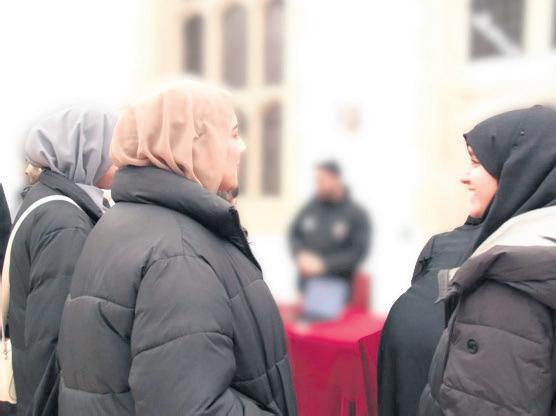
hall times, gyps without stoves or freezers and di culty nding halal food.
But what stands out to me is that every student I spoke to has found a sense of belonging in Cambridge. ISoc for one is a thriving community: the WhatsApp groupchat buzzes with event reminders, study group arrangements and supportive advice.
Of course, there is no homogenous “Muslim culture”, just as there is no sin-
Christian students of all denominations meet in various faith-based societies and organisations. Fisher House tends to Catholics; Student Christian Movement meets in Michaelhouse, to discuss faith and social action. e Christian Union is perhaps the most extensive and in uential, its members often the lifeblood of Cambridge’s central churches.
Students mingle with their communities at Bible study groups, at church events, or over a hot drink after Sunday services. e week is packed with religious activities, drawing connections between University and town. My meeting house is populated by both alumni and locals. rough talks, interfaith events and food banks, faith becomes the beating heart of our dayto-day lives.
ere is no universal Freshers’ experience, however, and other ISoc members tell me they were able to integrate into college life through alcohol-free social events. “I think having non-drinking activities in Freshers’ timetables is so important. Most of my friends now are people I met this way during Freshers’ week,” Farah tells me.
e prevalence of alcohol-dominated events means opportunities for socialisation are signi cantly narrowed for students who choose not to enter spaces
A representative for ISoc tells me about the ongoing battle to nd more prayer spaces for students. ere is only one prayer room owned by the University, located on Sidgwick Site. Students who use the prayer room tell me it is an important space for community, where you can always see familiar faces. Paired with the absence of Muslim chaplains in colleges, the lack of spaces like this is both disheartening and highly inconvenient for Muslim students.
Summing up his experiences, Abe explains: “It’s always small things – they add up.” From having to justify why you aren’t drinking, to being forced to delay daily prayers due to lack of prayerspaces, the obstacles faced by Muslim students are numerous. Ramadan at Cambridge is a particularly di cult time for students who fast, with inconvenient
gle “student experience”. Nevertheless, despite the apparent di erences between university and Muslim culture, it is clear that what unites them is stronger than what divides them. “I don’t think there is such a disparity with being Muslim and uni life – at the end of the day, most of us are here to learn and are respectful of each other,” says one student.
“I think it’s been a big learning curve,” another student concludes. “It’s been interesting to put those boundaries in place for myself.”
Some students’ names have been anonymised at their request.
❝
10 Friday 3rd February 2023 Features
When you have a scarf on, it feels like everyone is wondering why you're there ❞
10
▲Photo by Charlotte Conybeare
❝
It's always the small thingsthey add up ❞
❝
❞
Faith becomes the beating heart of our day-to-day lives
▼IGORS JEFIMOVS
Lara Ibrahim speaks to Muslim students about navigating Cambridge and nding community through faith




With Us #WeAreCisco Be You, Software Engineer cs.co/ensoft Follow @WeAreCisco
Comment
Esme Bishop
Picture this: it’s a Friday night. Bored of the library, you pack up and head to towards the chapel — but the chapel is not what you’re here for. You enter a side door and follow a narrow staircase down to another, glass door – it really looks like it should be a push, but you know that it’s a pull. You’re met with the smiles of the bartenders; your friend is on shift tonight. e sound of music, just a bit too loud, lls the room to its arched brick ceilings, always a re ection of whoever is working. e somehow both sweet and acrid taste of Clare lager tingles on your tongue, and in you go. Tattered but absurdly comfortable sofas, cluttered sound equipment, and a mysteriously sticky pool table: you are in Clare Cellars, and life is good.
Clare Cellars is one of the most popular college bars in Cambridge. Universally loved for events like Clare Jazz and Queer Night, it is a social space of central importance, for both the Clare community and for the University as a whole. It is also, for now, one of the only entirely student-run college bars left.
Is Clare killing Cellars?

It functions transparently: there’s a bar president, who until this year was chosen by the outgoing president (now, they also have to be approved by college management) who oversees the running of the bar, and a committee of Clare students: shift-manager, treasurer, stock, bookings, maintenance, and events –and then, of course, there are the bar workers. Shifts are organised exibly, providing students with the opportunity to earn extra cash without jeopardising their studies. is philosophy trickles down, producing one of the friendliest
bar atmospheres in Cambridge. Despite the success of this tried-andtrue model, the committee were recently informed that the College has begun interviewing candidates for a “newly created role”: an external supervisor “with the main responsibility of running the College Student Bar”. e successful applicant would “manage the student Bar Workers, be in charge of rotas, ordering stock and managing the Bar and JCR Events bookings” – in other words, a job description which outlines exactly what the existing bar committee already does, and very successfully at that. is announcement has outraged Clare’s students and alumni. Cellars' student-run status is at the heart of its tradition, culture and appeal. A survey of current students and Clare alumni compiled by the Bar Committee revealed widespread disapproval with the decision, with many seeing it as evidence of the College's fundamental lack of respect for its student workers. Others felt patronised and expressly uncomfortable at the prospect of having an external person supervising them on shifts. “I feel
Hugh Jones
“Personal statement”. Two words sure to make any Cambridge undergraduate inch. ey conjure up unprocessed trauma from the admissions cycles of yesteryear – and make us cringe at past attempts to convince admissions tutors that having been elected bin monitor in year 6 makes you the academic equivalent of 'not like other girls'.
Five years from now, however, rather than inducing a nervous twitch, saying those two terrible words on the Sidgwick Site will generate nothing more than blank stares. For UCAS is ditching the personal statement and replacing it with a more structured set of speci c questions. Cambridge is cheering them on.
Kim Eccleston, UCAS’s head of reform, has said she hopes the move will “create a more supportive framework” for students, as well as “broaden participation”. Given that UCAS polling last year showed that 83% of students found submitting a personal statement stressful, and given that progressive academics have been gunning for personal statements as “barometers of middle-class privilege” for a while now, it’s easy to infer what she means: personal statements are too dif-
deeply saddened that College does not value its students enough to trust them and allow them agency in their own college,” expressed one bar worker. “Who is the bar for, if not for its students?”
Clare College administrators appear to view students working in the bar as a hobby or an extracurricular activity. is is completely out of touch: as enjoyable and ful lling bar work is, it is also a much-needed source of income for many, even more so in light of the cost of living crisis. e unnecessary hiring of a bar supervisor should be seen for what it is: the rst step in the killing of Clare Cellars, which jeopardises its role as a safe and inclusive social space as much as it threatens
the nancial security of its student workers.
e motive for this callous decision is no mystery: a former bar president said that they were, upon being appointed, “charged with the task of making the Bar as pro table as possible”. e bar is not for anyone it would seem, but rather for the nancial bene t of the College. Unsurprisingly, it seems student workers were not good enough at prioritising the College’s nancial interests above the needs of other students.
Clare’s College administrators are not the rst to sacri ce character and a ordability to maximise pro ts. King’s and Selwyn are among the latest victims of this trend, with the former’s bar now colloquially referred to as the “Premier Inn Bar”, t for conference attendees and wealthy donors, with overpriced drinks to boot. Making pro t the sole purpose of a student bar – especially Cellars which, crucially, also serves as the College JCR –goes against everything colleges should seek to nurture and protect. is is a university, after all, not a business.
UCAS: Don't scrap the personal statement



Doing
cult — except for well-coached private school pupils.
I’ll start with the rst objection by claiming, heartlessly, that applying to university should be di cult. I am sure that it is easier to answer a handful of generic questions than it is to justify your existence in a 47-line, 4000-character essay. But UCAS’s polling also found that 72% of students felt positive about personal statements. Students found being forced to think hard about a lifechanging decision stressful. But they found it valuable too.

Are most personal statements masterpieces of self-discovery written in clean, sharp prose? No. By and large they’re ramblings about the personal growth engendered by bronze DofE.
But they, at least in theory, put self-expression at the heart of an otherwise all too bureaucratic system. Take away the personal statement, and the university admissions process (Oxbridge interviews aside) would involve little more than weighing GCSE results and predicted grades. is would deny students the chance to show skills that those data points might not re ect.
Axing the personal statement, unsurprisingly, depersonalises the application process. It stops really brilliant applicants from showing what they can
do, and those in di cult circumstances from giving admissions tutors the information they need to make a fair decision. If applicants themselves think the stress of writing a personal statement is worthwhile, UCAS should acknowledge the same.
e second claim levelled against the personal statement, that it suits coddled private school pupils too nicely, is obviously correct. As a coddled private school alumnus myself, I can conrm that my English teacher and my school’s head of university admissions both looked over my personal statement many times, suggested changes, and o ered feedback. I am sure that what I produced was better for their help.
e problem, however, is that private schools are always going to outperform state-funded ones, because they have access to far greater resources. I imagine my old school is rather pleased with UCAS’s proposal to make the personal statement more structured. By making the process simpler, UCAS lets private school teachers tell their students more or less exactly what to say. e current open-ended exercise, by contrast, resists coaching and rewards the kind of creativity that cannot be taught.
e fact is that the personal statement is broad, tests valuable academic
skills, and avoids the myriad cans of worms that would be opened if UCAS went ahead with its other suggestion: replacing the statement with a prerecorded video. Introducing secondary
a decision with this in mind. In an imperfect world, the personal statement is the best option available.
Ditching it, then, is a very obvious mistake on UCAS’s part. So how did it get made? e answer is that mistakes like these are the product of letting political pieties come before good policy.
factors like accent, posture, even dress sense and physical appearance, into the admissions process, as a video surely would, is never going to make things fairer. Additionally, while the personal statement does bene t private school pupils on paper, university admissions tutors are not fools. ey have access to a range of contextual information, and know that a private school statement has been practically ghostwritten by a team of teachers. ey are capable of making
UCAS feels that because the personal statement bene ts privileged private school pupils, it has to go. It doesn’t matter that that privilege is deeply entrenched, and that nothing UCAS does can fully level the playing eld. It doesn’t even matter that the personal statement as it stands is probably the fairest option anyway. In the world UCAS’s executives seem to be living in, there is no such thing as a compromise, or accepting something as the lesser of two evils. If a policy transgresses, it must be cast out. e personal statement’s demise is another product of the replacement of realist policy-making with ideological purity tests. As a result, young people will lose a valuable chance to be challenged academically, our university admissions system will become yet more impersonal — and inequality may well get worse. Perhaps if someone had made UCAS justify their decision in 4000 characters, they’d have realised where they were going wrong.
12 Friday 3rd February 2023 Comment
so might look progressive — but depersonalising admissions helps no-one
Interested in writing for comment? Email comment@varsity.co.uk with a short 100 word pitch!
❝
The personal statement rewards the kind of creativity that cannot be taught ❞
❝
Cellars being student-run is at the heart of its tradition and culture ❞
Student bars should not put pro t before people
FAMKE VEENSTRA-ASHMORE ▲
From tra c cones propped up in staircases to formal forks lined up neatly on bookcases, Cambridge students revel in the cheap thrill of taking something from their college… and putting it somewhere else. is impish instinct has us in its grips. ere’s apparently an invisible demarcation line around the university, one that establishes it as a world in which theft seems in nitely more alluring than it does anywhere else. Back at home, I was always wary of the consequences of stealing things from those in authority. Sod’s law felt palpably real, as I was haunted by the gut feeling that somehow I’d always get caught.
Upon arriving at Cambridge, this was turned on its head. Older years displayed their pilfered crockery like family heirlooms, friends cooed in awe at their mate who swiped the Master’s name card after formal, and there were always mutterings about bigger and more ambitious heists. Only last Michaelmas, news of the candlestick that had mysteriously “disappeared” and then re-appeared in college was the topic of conversation for a solid week or so (“Butcher, Baker, Candlestick-taker” becoming my go-to
Why do Cambridge students love to steal?
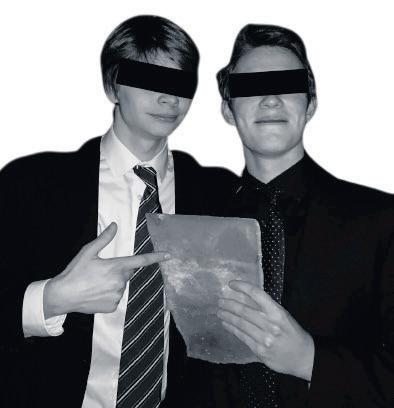











From crockery to candlesticks, we can’t seem to resist the allure of crime
cheap quip at the time). A friend from my own college admitted having taken “just” a fork, only to follow up by mentioning his mother displays it in their home. A Newnham student who had taken their fair share of Christ’s plates remarked that they wanted a collection for when they’d leave Cambridge. Everywhere you go you meet someone who has taken a little piece of college away with them. But why?
someone from beyond “Reality Checkpoint”. A few words spring to mind: “Academic rigour”, “history” or even “innovation”. But I think there’s also a real sense of “magic”, a folkloric quality to these walls. It’s what we emphasise to prospective applicants on open days. Yes, there is a lot of chat about ensuites and gym facilities, but there’s also always a mention of quirky traditions and the surreal nature of Cambridge life. Dashing across the grass before the porters catch you, various not-so-secret ‘secret’ societies, the urban legends of pennying, punting, and porterings going on. ese all add to the story of this place, and the few places like it.
What is it about Cambridge that compels people to behave this way? Everyone who had admitted swiping the odd plate or two said they wouldn’t do so at home, or at any other university, really. Picture in your mind what this institution may uniquely be imagined to be like for



What’s this got to do with taking things from formals? Well for a lot of us, the magic of the university is somewhat defanged and demysti ed upon arrival. It’s hard to feel especially part of the academic fairytale whilst trying to juggle supervisions and nights at Revs. Now, since anyone can bring back a coaster or a postcard, the best way to con rm that they’re part of this “mystical” world within a world, is to take things that really only university members have the chances to take. Unlike a giftshop Cambridge mug, a stolen spoon is the physical con rmation that you’re “in”,
as is the story behind it. Tales like the chair taken from Sidney’s lawn become part of the fabric of the university’s oral history, and there’s no reminder of your time here more permanent than going down in the annals of college larceny. Occasionally, of course, there are consequences. In practice, however, colleges are more likely to just give their students a mere slap on the wrist or a strongly worded email when things do cross the line. ere are simply too many instances to be able to chase all of them up, so this unwritten tradition is only brought to our attention when the more valuable items go missing. e way it persists despite the o cial curbs makes it seem a lot less like pickpocketing and more like taking mementos from some ancient ruins. Still theft, sure, but one motivated by a sense of wanting to be part of something bigger than yourself. As one thieving interviewee I asked put it, “you want to feel important – Cambridge and Oxford feel important”.
For many, everyday life at Cambridge seems surreal, and the occasional theft appears to inject a dash of sophomoric fun into accepting it as our day-to-day reality. Either by bringing a small trinket back home or, better yet, by becoming yourself a little piece of the university’s thieving folklore, you always seem to be one butter knife closer to feeling a true part of the story.
Cantabs just wanna have fun: what’s the best night out in Cam?




Your favourite Varsity writers o er their hottest takes on the mystery that is Cambridge’s nightlife
 Asha Birdi
Asha Birdi





e best night out in Cambridge is so bad it’s good. It’s Sunday Lola’s. Going to Lola’s requires grit and dedication. Tickets for Lola’s are like gold dust. I spend hours of my Sunday scouring Facebook, spending whatever’s left of my weekly budget to have a chance of lining up in its prestigious ticket queue. And for what? is ritual is at least an hour long, usually in sub-zero temperatures. In a desperate attempt to make the experience more bearable, my friends and I pass round stomach-turning drinks in reused milk cartons, containing more vodka than mixer. Inside is even worse. e music is terrible, drinks extortionately-priced and, worst of all, the place is heaving with men in drinking soc ties. If I’m not lost, crushed and su ocated, I’m pleasantly surprised. Each Monday morning at 3AM, I swear that I’ll never return. Yet, by the following Sunday, I nd myself back on Ticketbridge, ready to sell a kidney to return. I don’t know what it is, but Sunday after Sunday, I just keep coming back for more.
e best night out is the simplest one: go to the pub. Feeling down? Go to the pub. Feeling up? Go to the pub. Feeling slightly in-between those two options? Go to the pub. Which pub? e pub. ere are many to choose from, but one thing is certain: they all ful l the criteria of being a pub. Any pub that you can go to, you should go to (although I have a soft spot for the Elm Tree). Nowhere else but the pub can I spend £12 for two mediocre pints, before drunkenly stumbling into hour-long conversations discussing everything from EU passports to Donkey Kong. A night in the pub puts one somewhere between a philosopher and a court jester. e chatter is often madcap and meandering, but if you’re among friends, what reason is there to care? e closeness of those seats, the warmth of the lights, it all adds up to create fonder memories than the awkward chaos of the clubs. I will agree, it can be a bit unadventurous sitting in the same spot for the whole night. But the best nights are the ones where your next moves are made after the most crucial one: going to the pub.
e best night out in Cambridge is not a Slipped Disc All Nighter, a gig at the Cambridge Junction, the sweaty madness that is a Wednesday Revs, or even a sophisticated evening at the Arts eatre. It’s not a Union debate, a romantic dinner at e Ivy, a college formal, or a Varsity social (but feel free to join us fortnightly at e Anchor on ursdays!) In fact, the best nights out are the ones you don’t expect, when the pres are the end of a work shift, a seminar on the Renaissance you didn’t want to go to, or a long day in the library. e happy accidents. e chance encounters. e nights out wearing your glasses, not your contact lenses, and when your backpack and cycle helmet end up coming with you to the pub. e best nights out are those spent talking nonsense with your dearest friends, over a cup of tea at whoever’s accommodation is closest – because those are the memories we’ll cling to when our time in this city is done, not the Cambridge fripperies that sparkle for a only brief moment before vanishing.
My best night out at Cambridge required a reluctant change of heart. For all of second year, my friends and I complained about the endlessly thumping bass of LaRaza which kept anyone living in the neighbouring streets up until 4am. One evening, bored of Revs and Lola’s, we did the unthinkable and went to LaRaza ourselves for its fortnightly Funk Jam. Sober and feeling the midweek blues, we had the lowest of expectations — but this may have been part of the magic. A bit awkward at rst, the underground bar was soon lled with people boogying up a storm, as the live band’s clarinettist somehow managed to squat jump while playing. Funk Jam is an open mic night where acts hold the oor for only a few songs each, and its upbeat atmosphere is infectious. Live music with words you can sing along to (sorry Jazz Soc), no entry fee and a switch up from the countless nights of sameness at local clubs made me change my mind on LaRaza. e best night out at Cambridge was on my doorstep all along.
ere is no ‘best night out’ in Cambridge. It exists only in the fevered imaginations of serotonin-deprived students, myself included. is ‘best night out’ is merely an incentive used to deceive oneself into nishing that overdue supo work. Whether it’s Sunday Lola’s or Woo Wednesdays, you will be met with overpriced drinks (the cost of living crisis says hi), a frustrating amount of ABBA and a pervading sense of dissatisfaction when the night ends. e only good thing about Wednesday Revs is the idea of it. Nevertheless, the collective hope that, maybe this week, things might be better keeps us going back. My friends and I pathetically buy into it at every pres. We giggle, we self-deceive; we have a good time with the people we love and pretend that the rest of the night will be just as fun. Riding high on adrenaline, we ignore the impending disappointment. e doublethink would make Orwell shudder. So maybe sit the next night out and chill with some friends — we all know pres are the best bit anyway.
Friday 3rd February 2023 13
Comment
❞
❝ Theft becomes part of the fabric of the University’s oral history
Gwenno Robinson Fabian Apostoaie Lotte Brundle
Fabian Apostoaie
Clarissa Salmon
Two anonymous students relieve St John’s College of one of its roof tiles / Jack
Friendships are like ships — when you rock the boat too much, you are liable to capsize it. Lord knows, the seabed of my past relationships is positively littered with those that didn’t make it. Corpses of excolleagues, best-friend betrayers and, worst of all, the ones who got away lie waterlogged and forgotten.
For clarity, I didn’t drown my ex-boyfriends and leave their lifeless bodies to swim with the shes — although given what some of them got up to, many galpals said they would have deserved it. I just mean that, growing older, you nd that human relations are less like a pool of constant connections, and more akin to an ever- owing trickle of interactions. Often, strangers turn to acquaintances, who turn to friends, some to lovers –some not – before most become strangers again. Or worse – enemies.
“You can only have six real friends at one time,” my housemate stated condently the other week at our daily post-


Sorry besties, but most friendships don’t survive graducation
dinner gab sesh. Where did he learn this, I asked. Buzzfeed probably. Is it true? Oh, de nitely. As any good journalist would, to test his theory we carried out a thorough investigation. at is to say, we counted.
One, two, three, four, ve, six. We proudly listed the names of our nearest and dearest like they were condiment items on a shopping list.
If you consider yourself to be my friend and are wondering if you made the cut, sorry to break it to you. You didn’t. If you’re really someone’s friend, you don’t have to wonder. ose who know, know,
and I’d like to think my six are sure of it. It might sound brutal, but as I prepare to leave uni, I’ve been facing up to this stark reality. How many of these people will I really, truly know, once the bonds that tie us up in daily life are loosened?
Once the invisible threads that connect us to one another are not simply stretched across the city of Cambridge, but run county-, maybe country-, wide? e answer: very few. Once you make a change to your life, only the strong survive. And I’ve got my suspicions about who will sink and who will swim.
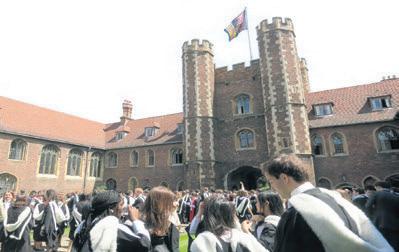
Call me a cynic (I’ve been called worse) but I’ve played the friendship game before, and I know how it ends. Very few players make it to the nish line. I’ve played the best-friend game too. And the boyfriend one (though admittedly in that particular category, I’m currently a three-year reigning champion). But it’s a universal fact that each human relationship is brutally punctuated by choices. Friendships do not renew automatically like a Net ix subscription. As you reach certain junctions in your life, you are forced to decide: do I carry on with this person, or do I jump ship? Or
else, take the easy option, do nothing, and eventually let yourself drift away from them. Worse, they might have already left you in the boat alone — you just didn’t realise.
As I learnt the hard way in rst year
to grow to be. My ‘best’ friends, not in the conventional use of ‘best friend’, are my friends who are, in my opinion, the best of people. Who are kind, who are good, who are honest, and who are loyal, and I plan to hold on, if they’ll let me, so that we don’t drift apart as Cambridge becomes a distant island on the horizon of our pasts.
Olivia Young
Seventeen seasons is an old and wrinkled age in TV years, and the creators of ‘ e Apprentice’ seem desperate for the show to feel young again. Much like a midlife crisis-induced Jaguar purchase, however, the result feels like a let-down — for both entertainment and inclusivity. Indeed, it seems its producers have decided the only way to keep their show fresh and attractive is to make the candidates just that.
In 2005, the only thing the contestants in ill- tting suits and somewhat awkward grey skirts had in common was their desperation to work with Lord Sugar. Skip forward to today, and it appears there are more stringent requirements to be among the lucky few ghting for his mentorship.
In what has been described as the Love-Island-i cation of ‘ e Apprentice’, the vast majority of its contestants are now young, very attractive and already boast social media followings. With all but three of this year’s contestants being
— the youngest person in a mature college, the oldest in my undergraduate cohort — making friends at uni is hard. Keeping them is even harder. So, I have decided. I’ve selected a bunch, like owers, those who bring the best to my life, who challenge me, who make me think deeply and passionately about the kind of person I want




at said, I am, after all, merely a captain of a six. In this friend-ship, there is limited seating, and once those 6 places are taken, I’m afraid there really isn’t room for any more passengers. Stragglers will, unfortunately, be thrown overboard. Let’s just hope the brutality of this article doesn’t make them all band together and decide that it’s me who should be made to walk the plank before graduation. Because, without my struggle a oat in
Cantab12 / CC-BY SA 4.0
e Love-Island-i cation of ‘ e Apprentice’


When did all reality television shows become beauty pageants?



under 35, we have to ask ourselves where the age diversity has gone. No one would ever want to watch a TV show with homogeneous casting based on race, ethnicity or gender — and for good reason — so why is it blindly accepted when it comes to age? Why should a show with cross-generational appeal like ‘ e Apprentice’ exclusively cast contestants from one narrow age group?
For a show that was traditionally good at promoting age inclusivity precisely by demonstrating how success can come at di erent stages of life, this shift has been more than a little frustrating. When
importance of highlighting individuals succeeding thanks to, and not in spite of their professional and life experience.
is bias is at the very heart of television’s ageism problem. According to research by the Centre for Ageing Better, only 3 in 10 believe that TV and lm show older people to be full of potential, with the same amount believing it makes being 50+ seem depressing and with limited opportunities.
Age is not the only factor at play: this new iteration of ‘ e Apprentice’ has a broader, more sinister obsession with appearance. omas Skinner, a contestant in 2019, has said that the producers made the hopeful auditionees arrange themselves in order from ‘prettiest to ugliest’; when did ‘ e Apprentice’ become a beauty pageant? Amy Anzel, a contestant on last year’s show branded it a ‘wannabe Love Island’ as ‘A lot of the female candidates are quite beautiful and it was interesting that the rst episode was on a beach’, joking that: ‘I’m surprised they weren’t in bikinis, but it is the BBC.’
questioned about the lack of older contestants on the show, Lord Sugar reiterated that ‘there are no age limits on applications’. Nonetheless, the fetishisation of reaching career milestones as young as possible is overpowering the
In what Lorraine Candy called the unwelcome return of the ‘1980s Boardroom Barbie’, women’s business attire now looks far closer to the misogynistic ideal male bosses dreamt up decades ago than ever since. is isn’t to under-
mine women who feel at home ‘power dressing’ in stiletto heels and hourglass bodycon dresses — it is simply to question the notion that this should serve as a mandatory uniform for female ‘Apprentice’ contestants and women in business more generally.


e series has also faced allegations
Of course, there is no escaping that television is a visual medium and being intelligent and attractive are certainly not mutually exclusive.
However, the show’s blatant preference for looks over entrepreneurial spirit is problematic for what purports to be a ‘serious business reality show’. On a show which should judge candidates rst and foremost on the basis of their business competency, the choice of ageism and lookism as selection criteria is worryingly outdated.
that producers intentionally shy away from platforming smart contestants, instead promoting ditzy and uninformed, stereotype-bound characters - especially women. Former show aide Nick Hewer has levelled that “the most intelligent candidates are never selected for the show, because audiences couldn’t keep up”, and that producers tried to prevent a contestant from being red because she was blonde and ‘thick as a fridge door’.
ese issues are wider than their display on the set of ‘ e Apprentice’. Despite being one of the most pervasive forms of bias, ‘pretty privilege’ is hardly ever acknowledged nor engaged with on serious terms. And yet, studies routinely demonstrate that attractive people are more likely to be interviewed for jobs, hired, promoted and even earn around 15% higher wages than their less conventionally attractive counterparts.
e Apprentice’s producers believe they are trading inclusivity for the easy rating gains of the young and beautiful. ey could not be more wrong. Setting such stringent preconditions for achieving reality TV success could potentially narrow the target audience of the show and alienate viewers seeking relatable personalities.
14 Friday 3rd February 2023 Comment
❝
The most intelligent candidates are never selected for the show
❞
❝
This new iteration of
❞
‘The Apprentice’ has a sinister obsession with appearance
In a sea of friends, most of you are getting fed to the sharks when I graduate. If you don’t throw me overboard rst, that is
❝
Lotte Brundle
❞
Friendships do not renew automatically like a Netflix subscription
❝
❞
▲
It’s a universal fact that each human relationship is brutally punctuated by choices
mates, I’d really to keep myself
Why CU Nigerian Society want the Benin bronzes sent back
Riannon Chaplin
“ e society really provides a space for students to feel a link to Nigeria while they’re here,” Folakunmi Pinheiro, president of Cambridge University Nigerian Society (CUNS), tells me. He is open and friendly, and speaks passionately about the society and its impact.
It was the Museum of Archaeology and Anthropology (MAA)’s decision in December 2022 to return its looted Benin bronzes that rst prompted me to sit down with Folakunmi, and fellow CUNS member, Stanley Jachike Onyemechalu. But I am also keen to learn more about the society’s work and its role in the Cambridge community.
In particular, the society aims to put on events for Nigerian students and those interested in Nigerian culture. One of their favourites is the Ówàńbé, a traditional party with Nigerian food, music, dancing and games, which the society hosts at the beginning of each academic year. “It helped me to step back from work,” Stanley tells me, smiling. “I could dance, for the rst time in a long time, to Afrobeat and Nigerian music, and ate food that tasted like home.”
It’s this sense of community and

one there who is striving and trailblazing.”
What was their reaction, then, to the MAA’s decision to return 116 Benin bronzes to Nigeria? “Finally!” says Stanley, and his exasperation is clear.
e bronzes refer to a diverse range of thousands of objects made from brass, bronze and other materials, such as ivory, which were looted and later auctioned o after the sacking of Benin
student in archaeology, tells me. But he urges caution — if there has been a change in public opinion, it has still not been enough to force the British government to act. is may be partly due to the persistence of some myths around museums’ rights over the bronzes.
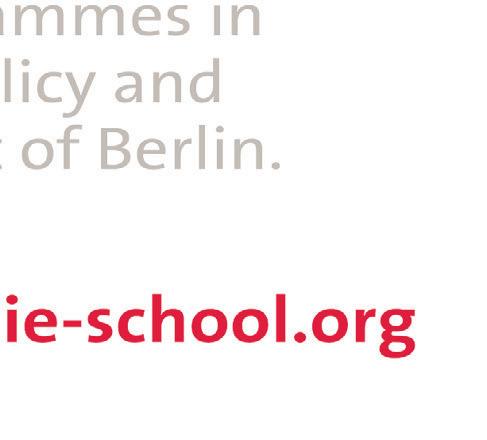
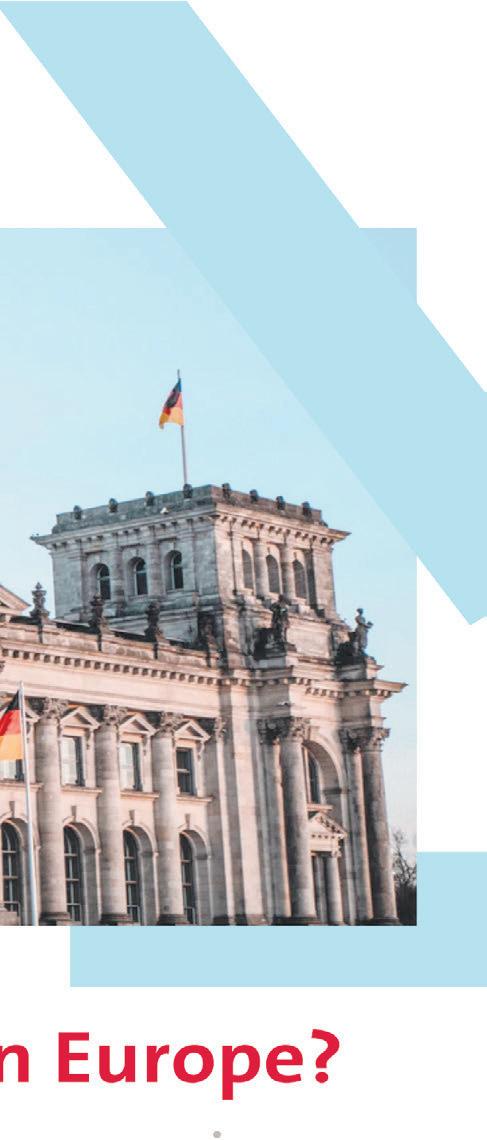
cultural connection that makes the society so valuable. “It provides a space for Nigerian students to feel safe at Cambridge, and feel like they can have a taste of Nigeria even though they are 3000 miles away,” Folakunmi adds.
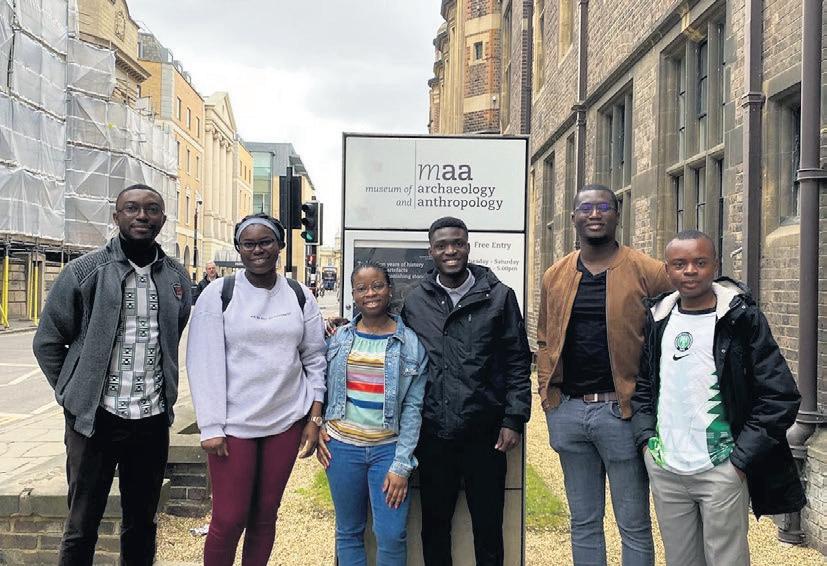

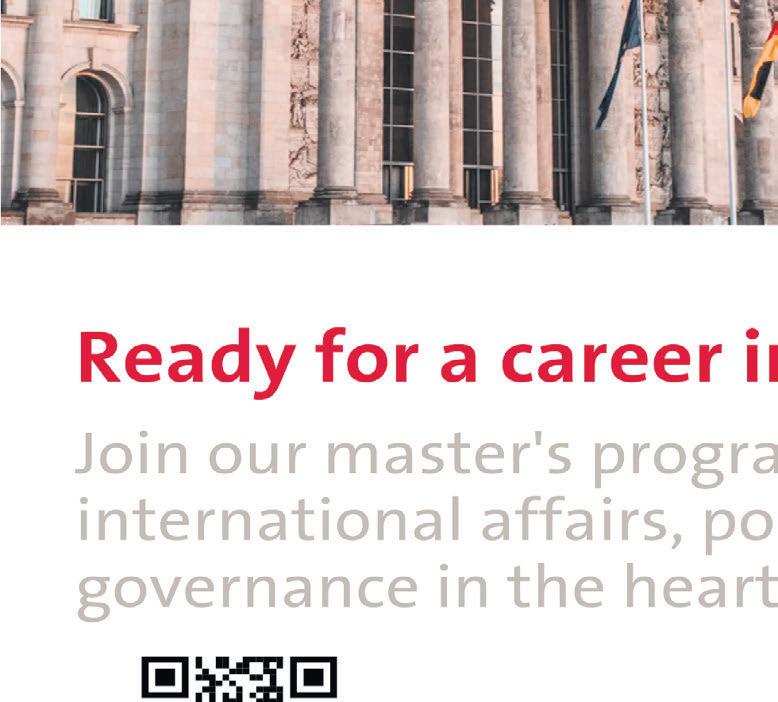
He is particularly proud of the annual Democracy Day event, which celebrates the handover of power to an elected civilian government in 1999. Last year’s symposium hosted Noimot Salako-Oyedele, Deputy Governor of Ogun State and one of the few prominent female politicians in Nigeria. “It’s very uplifting for us,” Folakunmi, a PhD student in Law, continues. “ e women in the group can see that there’s some-
City in the Kingdom of Benin by the British in 1897; the country we now know as Nigeria did not yet exist. eir cultural, historical and spiritual signicance is hard to overstate.
“ ey tell the history of the community and the kingdom,” Stanley explains. “ ey were a set of writings, a sort of library, with pages of objects that told stories about the most signicant moments in history. Many were not supposed to be seen by people outside a speci c group.”
It is hardly surprising, then, that many believe the display of the bronzes in museums across Europe and North America to be a continuation of imperial violence, of what Stanley calls the “destructive injustice” which stains colonial history. In October 2021, Jesus College, Cambridge became the rst institution in the world to return a Benin bronze. Later, in September 2022, Germany agreed to return dozens of bronzes to Nigeria, and in October of that year the United States returned 31 bronzes from two institutions..
It appears there has been a shift in opinion in both academic and public spheres. e University of Aberdeen has also returned its bronzes, and Glasgow Museums and the Horniman in London have promised to do the same. Is Nigerian Culture Minister Lai Mohammed right when he says that it’s a matter of ‘when, not if’ the British Museum does the same?

“Of course,” Stanley, himself a PhD
Folakunmi points, for example, to the popular notion that more people will be able to see the bronzes if displayed in a national museum – the British Museum is thought to hold around 700 of them. But this, Stanley says, misunderstands the bronzes’ original purpose as objects of deep cultural and spiritual signi cance, never intended to be so publicly displayed thousands of miles away. Recalling a CUNS trip to the MAA, Stanley tells me of students’ reactions to seeing the bronzes in glass cases. “You could just feel the emotions they had. What is it doing here? Why is it here? Send them back. ings like that.” Yet he believes that govern-
ment red tape enables institutions such as the British Museum to hide behind the law. Here he is referring to the National Heritage Act 1983 and the British Museum Act 1963, which the museum has argued prevent it from returning such objects and which non-national and university museums are not subject to. And so the issue is swatted between government and museum without real progress, never high enough on the agenda to exert real pressure from voters. “Repatriation is just one step
in seeking justice for past injustices.” e importance of CUNS’ work in providing a safe, vibrant community couldn’t be clearer, with music, dancing and food that tastes like home. e Benin bronzes and the academic and public debates happening around them are deeply signi cant to the diverse Nigerian cultures the society celebrates. “It’s the Benin bronzes now,” Stanley says as we wrap up the interview, “but it could be another people’s cultural materials later.”
Friday 3rd February 2023 15 Interviews
❝
ey tell the history of the community and the kingdom
❞
❝
Repatriation is just one step in seeking justice
❞
▼ PHOTO CREDIT TO CU NIGERIAN SOCIETY
Getting things in order with John Bercow
e former Speaker of the House of Commons about his controversial career and how to shut up a room full of MPs
Chris Patel
irty seconds into my conversation with John Bercow, I know one thing for certain – it is nearly impossible to interrupt him. But if you could limit him to one word, it would be a sonorous roar of ‘Or-derrrrrrr!’. I ask him if he ever goes the opposite way, and embraces a bit of chaos. “In retirement, you’re more inclined to do so”, he tells me. When he was Speaker, quite the opposite was true – he stuck steadfastly to his station. “I was sometimes accused of hogging the chair”.
Aside from accusations of overstaying his welcome as Speaker, Bercow’s political critics, particularly Conservatives, loved to accuse him of impartiality. “I frequently made decisions which somewhat irked the Cameron government, which gave an opportunity for Eurosceptics to express their point of view. ey were able to challenge ministers with urgent questions that I granted because I took the view that, although they were a minority, they were an important minority and their view had to be heard. Unfortunately, when I did the same for Remainers during the Brexit period [...] they didn’t like it.”
From 2009 to 2019, Bercow commanded the House of Commons from the vantage point of the chair, and was often more e ective at calming down the house than many of the other Speakers we’ve seen. When the chamber became cacophonous, Bercow resorted to teacherly tactics: “One technique that
was quite e ective was to say, ‘Look, it doesn’t matter how long it takes, I’m going to get through this order paper [...] If we have to sit here for another 10 or 15 minutes, 20 minutes, so be it.’”
e most disorderly MP on each side of the house, Bercow recalls, were the Conservatives’ Michael Fabricant (“regarded himself as a very signi cant gure, I always thought he was a rather
absurd individual”) and Labour’s Karl Turner (“goes from 0 to 60 in about ve seconds” but “would come up to me afterwards and apologise”). Overall, Bercow characterises his leadership style as “ rm voice, and good humour.”
Maybe too rm a voice, and not enough good humour? Last year, an independent inquiry, which upheld 21 out of 35 complaints made against Bercow
by former colleagues, judged him to be a “serial bully”. Bercow maintains that, due to the statute of limitations, these charges wouldn’t have been heard in court.
“Some of these events were 12 years ago, including, for example, the question of whether I stared at somebody in a hostile way, on a date which the complainant couldn’t remember.” Bercow has
not spoken to any of his accusers since: “I left that workplace 3 years ago, so why would I make contact with them?”
Bercow maintains that he kept “fantastic relations” with all of his sta members but his three upheld accusers. “And I had an overwhelmingly stable Speaker’s o ce, in which the turnover was relatively low.” His bugbear, he says, was overly o cious advisors: “I insisted on running my o ce, not being run by it. [...] You’re absolutely entitled to o er your advice. But I was elected, and re-elected and re-elected, which no Speaker in the post-war period has been.” Bercow’s one guilty plea is “to being a very decisive character.”
After we discuss his past, Bercow looks to the country’s future. He calls Liz Truss, uncontroversially, an “unmitigated disaster”, and says that the current Conservative government is potentially in “terminal decline”. He wants to see more Prime Ministers from non-Oxbridge backgrounds, feeling that being as “materially privileged” as someone like David Cameron or Rishi Sunak makes one necessarily out of touch with the electorate.

John Bercow is a paradoxical and divisive gure – 5’6” but larger than life, warm in public but accused of bullying in private. However, he does not shy away from what people say about him. As he wishes me the best of luck in my future endeavours, he announces that “you’ll write what you will” – and if people can’t handle that, Bercow says, then maybe a career in politics isn’t for them.
Cambridge’s Iranian students speak out
 Chris Patel
Chris Patel
On the 16th of September last year, 22-year-old Iranian Mahsa Amini was beaten to death by the ‘morality police’ in the Islamic Republic of Iran, after they arrested her for supposedly improperly wearing her hijab.
is provoked worldwide outrage, but as the events in Iran fade from our news feeds and social media pages, it is easy to forget that protests are as strong as ever: Iran is in the middle of a revolution.
ree Iranian Cambridge students agreed to speak to me about how the revolution has transformed their lives.
Kimia* was in Iran when Mahsa Amini was killed, and left 10 days into the protests. “I heard shooting, I smelled tear gas, I smelled smoke.” Being a woman in Iran amid the nascent revolution was particularly terrifying, as she tells me that the morality police have arrested her many times, even when she “literally had the most amount of hijab possible”. Even though she’s not in immediate danger while in Cambridge, Kimia has “been having more panic attacks than [she’s] ever had in [her] life” over the past two months.
It is extremely di cult for Iranian students to contact their families. Kimia explains how the Islamic Republic government has blocked access to all messenger apps, and is now even making communication via VPN impossible by using a rewall.
Iran’s internet is so slow that even
when she can brie y call her parents, they are abruptly disconnected. All three students we interviewed worry about their families, because, as Kimia says “I know how brutal [the morality police] can be even when you are not protesting.”
All three students also have friends in prison, with Mehdi* mentioning a friend who was imprisoned and tortured for a week for protesting. Four men have been executed since the revolution began, following summary trials, often without a lawyer, but Mehdi argues: “executions don’t silence people at all”. If anything, “there’s more rage.”
Mahsa Amini’s death was not the start of the unrest in Iran – there have been tensions since 1979, when the Islamic Republic was rst established. Mehdi explains that the IRGC (Islamic Revolutionary Guard Corps) have long been committing acts of terrorism, such as shooting down a Ukrainian ight in 2020. Saeed* adds how, more recently, “there’s been incidents where [the morality police] blind people,” while Kimia recalls that “they literally shot a person who was taking a video” of the protests.

So what are Iranians ghting for? In three words: ‘Woman, Life, Freedom’. e students emphasise that Iranians are not protesting against the hijab, they are ghting for a woman’s right to choose whether she wears one. Kimia explains that the misconception that the recent protests are anti-hijab is exploited by the moralising Iranian government: “what they are saying is that people want to
get naked”.
ere are many di erent reasons why Iranians are ghting. e students directed me to a song by Iranian artist Shervin Hajipour called ‘Baraye’ (Persian for ‘For’), which has become hugely popular in the revolutionary movement. e themes in his lyrics range from “child labour” to “polluted air” to “the fear of kissing” one’s lover in public. Predictably, since releasing ‘Baraye’, Hajipour has been arrested.
As ‘Woman, Life, Freedom’ suggests, the Iranian revolution is a women-led revolution – the women of Iran earned Time Magazine’s Heroes of the Year award in 2022. Mehdi notes how, since the rst Iranian Revolution in 1979, the percentage of women who complete primary education has increased massively, from around 30% to the high 90s. “ ey know what they’re doing, they know their history”. Saeed adds, “maybe that’s why the Taliban doesn’t want a woman to be educated.”



is is, however, not just a women’s revolution. Mehdi mentions the chant: “from Kurdistan to Tehran, I’ll die for Iran”, to illustrate that supporters of the revolution come from all over. “For 44 years, the Islamic Republic has been saying that if they are not there, di erent parts of Iran are going to get separated. But in 44 years, I’m telling you, Iran has never been united like this before.” at’s the reason, Mehdi continues, that what some call protests, or a crisis, Iranians from all walks of life call a revolution – because they are con dent that
a change will come, “even if we don’t see the results in the next two months, three months or next year”.
Kimia, Mehdi and Saeed are all extremely active on social media and speak at many protests, and they know the consequences of this – if they were to return to Iran, they would be arrested at the airport. Movingly, Mehdi tells me how he doesn’t expect to ever return to Iran. “It wasn’t an easy decision at all. I was born and raised in Iran. Until I die, Iran will be my home.”
e students point out that Western countries’ responses, namely sanctions targeted at the Islamic Republic, are ineffective, because they hit speci c people rather than nancial institutions. ey also say that the University of Cambridge needs to do more to support the people of Iran. When Mehdi emailed Pro-ViceChancellor Kamal Munir in October, asking if Cambridge would issue a statement condemning the Islamic Republic’s actions, Munir said no, dismissing it as one of “several live con icts around the world”.
Mehdi cannot help but feel aggrieved, given that Cambridge released a statement condemning Putin’s invasion of Ukraine just 8 months before. e University also provides a Hardship Fund for Ukrainian students, but no such scheme exists for Iranians, despite the fact that Kimia’s master’s degree “[costs] 40-50 years of an average worker in Iran’s income”.
I conclude by asking Kimia, Mehdi
and Saeed if there is anything ordinary people can do to help the cause. ere is plenty, they assure me. Email your MP. Be there for your Iranian friends – “not just Iranian friends, Afghan friends, Ukrainian friends.” e easiest thing to do, they say, is to “use your social media [...] by sharing the things that are coming from the people of Iran”.
Some Iranians who live abroad, she explains, do not protest or repost about the revolution because they want to be able to travel to Iran with impunity to see their loved ones, but Kimia has no patience for these people. “I don’t want to travel to Iran, I want to live in Iran”. e only way to achieve this is for the world to speak out.
* Names have been changed.
16 Friday 3rd February 2023 Interviews
▼ ALEX LAU
ree Iranian students speak to Chris Patel about Mahsa Amini, the morality police and what Iranians are ghting for
Breaking down STEM Superiority: e experience of a medic intercalating in humanities

 Toby Smallcombe
Toby Smallcombe

One of the big decisions medical students have to make during their undergraduate degree is what subject to take during their third year. For a lot of students, this boils down to whether they want to do a project and write a paper or take a ‘year o ’ after a hectic second year. I thought there was no better way to do this than to spend my third year doing History

So, what’s the deal with STEM, why would I have ever wanted to leave? Somewhat tting with the alleged ‘grind mindset’ attributed to STEM students, STEM degrees can be really draining. I found that second-year medicine moved at a relentless pace, jumping from contact hour to contact hour with few breaks in between. Pre-clinical Medicine started to feel stagnated, parroting facts and working through methodical problem sheets. e promise of a more free-form structure and seemingly optional lecture timetable became all too intriguing.
How people react to my transition to History hints at the dichotomy between STEM and Humanities. STEM students mostly seem relatively unbothered, most interested in how I’m spending all my new free time. Humanities students on the other hand seem impressed and excited to hear how I’m nding the new degree. is discourse has been seething on the University of Oxford ‘confessional’ Facebook page recently and the alleged superiority of STEM over Humanities de-
grees is a frequent topic of discussion on Camfess.
In what other ways do medicine and history di er? Ironically, given the stereotype of Humanities as a social degree, I’ve found history has been a much lonelier experience than Medicine. e structure of Medicine meant I was always busy, with short-term but manageable deadlines constantly throughout the week. Lectures and practicals are a social event, with the whole cohort gathering daily and a great time to catch up with friends in and out of college.
studying History
Motivation and discipline are key as a Humanities student, in contrast to medicine I will typically have two big deadlines a week and maybe a similar amount of lectures. Free time becomes its own burden, with little to organise yourself around. is all paints a very sad picture, but I’m also having the best year of my university experience so far. History does
Research Round-up
Suchir Salhan and Tom Malloch

give me time to relax and engage with friends, as well as myself. I’m by far the ttest I’ve been at university and have become much more proactive in my social life. Honing the skills to make and allocate time both for work and yourself is crucial, and Humanities degrees help you do that.

A lot of people ask what I hope to get out of a History degree, given that I’m still planning on heading to clinical school. At its most basic – rather than having a year o – it’s more that I’m hoping I’ll be refreshed and excited for clinical school after a year of doing something di erent. In a six-year-long course, a little bit of change is a good thing. Critical thinking and motivation that I’m developing by studying history will be very useful at clinical school and beyond. Despite the idea of Humanities degrees allowing laziness, I’ve become much more productive this year as a result of changing my work habits and adapting my way of thinking. Overall, I know when I look back on this year, I’ll miss it. is is by no means a piece against Medicine or STEM or a love letter to Humanities and History. But having been part of both camps, it’s helped me appreciate the di erences between the two and the importance of broadening education. For anyone who is ever tempted to make a temporary or even permanent redirection, don’t let the rhetoric and distinctions between STEM and Humanities stop you.
Could YOU be the next Zadie Smith?
Rebuilding sheep from their skin
Scientists from Cambridge and elsewhere have tested an innovative technique, attempting to settle the ‘contentious’ chronology of the Agricultural Revolution.

Laying the groundwork for the Industrial Revolution, it saw the adoption of eld rotation, enclosure and wider use of fertilisers. Until now, traditional methods have proven inadequate to pin down the precise timeline of developments. e team measured the proportions of carbon and nitrogen isotopes in sheep parchment, used for dated legal documents. From this, they can reconstruct the sheep's health, diet and more, relating change in feed for instance to trade expansion following the Napoleonic wars.
Anti-depressants and the brain


Research from the Department of Psychiatry in collaboration with the University of Copenhagen has found that anti-depressants cause half of users to feel emotionally blunted. is is due to their e ect on reinforcement learning, which allows humans to form behavioural patterns from the environment. ey found no signi cant e ect on ‘cold’ cognition, like attention and memory, or ‘hot’ cognition that involves our emotions.
GPs: Can they understand us?
Our GP is usually our rst port of call for access to the NHS, so ensuring GPs understand our symptoms is therefore vital – both to maintain trust in the service, and even more importantly to guarantee access to appropriate treatment.
In a bid to improve GP care in the future, the team studied 28 taped primary care consultations of patients describing abdominal pain – although usually benign, it can be an important warning sign of serious illnesses, including gastro-intestinal cancers. ey found GPs more frequently wrongly interpreted patients' descriptions than correctly, especially when patients used vague description or referencing issues not already documented in their record.
Explaining the productivity slump
Recent analysis gives a potential resolution to the ‘puzzle’ of the UK's productivity slowdown. Cambridge economists used ONS data to decompose the economic growth into 19 distinct sectors, like manufacturing, nance and agriculture. e paper found within-sector slowdowns were on the whole responsible; mainly from ICT and manufacturing industries, though there was a slight e ect from labour reallocation.
Poetry, Prose, Art & Photography submissions for he Mays 31 are now open
Friday 3rd February 2023 17 Science
❝
❞
Critical thinking from
will be useful at clinical school and beyond
Cambridge at the bottom of Tripos for sustainability


 omas Idris Marquand and Suchir Salhan
omas Idris Marquand and Suchir Salhan
Cambridge University’s environmental policy has been ranked at the bottom end of a 2:ii class in an independent league table of UK universities ranked by environmental and ethical performance. Ranked 84th out of a possible 153 institutions, down two places from last year, the report suggests that the University has not met emissions targets. Cambridge sits below Anglia Ruskin, ranked in the mid 2:ii class, and signicantly below Oxford University, sitting at a comfortable 2:i, ranked 41st. First class universities include Bristol, LSE and KCL.
e ndings of the survey

Based on the University’s publicly available environmental policy, People & Planet found that the University is working to target Emissions and Discharges and Biodiversity, but is neglecting to set targets for other areas such as Construction & Refurbishment, Waste Management, Travel and Transport and Sustainable Procurement.

After a long year of climate protests in Cambridge, the University was scored zero out of ve for its commitment in policies to reinvest divested funds in re-
newable energy or community-owned energy. However, its Carbon Emission Plan is consistent with the 80% reduction in carbon emissions by 2050, with at least one milestone towards this target being set before 2030. e evaluation also comprised metrics associated with workers’ rights and the use of a “Can’t Buy My Silence” pledge, which makes non-disclosure agreements unenforceable for anything other than sharing intellectual property.
Varsity reached out to omas Idris Marquand, a PhD student working in the Department of Earth Sciences. omas studied Natural Sciences as an undergraduate and started working as a supervisor this year. He hopes to use his experience as a climate scientist to help undergraduate students understand how they can address the climate crisis and help shape the University’s climate agenda.
omas’ advice: how can students combat the Climate Crisis?
Tackling climate change is not always as black and white as we environmentalists would like it to be. Some fantasise about a technological saviour whilE others think that the solution is anything


with the word “organic” plastered on it. Our passion is all too easily misdirected, and our gut instinct often overruns our reason. In many cases, the rough stroke of common sense must be re ned by careful research and evidence.
Pinning down complex environmental problems is my full-time occupation at the moment; my PhD is all about how our use of land a ects greenhouse gas production and consumption. I feel very fortunate to take on a topic which attracts such passionate input from so many of the people I meet. In that vein, the mass mobilisation of climate activism, not least among Cambridge students, over the last few years has been really inspiring.
However, I sometimes worry that my protesting peers do not always direct their praiseworthy passion to the most e ective environmental solutions. e climate system is complex and environmental problems entangled. How can we strike the balance between recognising nuances and motivating people, governments and corporations to make necessary changes?
So many of the environmental issues that seem simple at rst glance raise deeper questions on further consideration. For example, organic farming produces less food from the same amount
of land; if we switch to environmentally friendly, low-productivity farming practices, we will need to import more food from abroad or convert more wild land to farmland. Electric cars present another complex balance of pros and cons. While the pros are generally accepted to win out, questions remain as to how we can ethically, safely and sustainably produce and recycle the rare metals needed to build their batteries. ere are even legitimate, though unpopular, arguments against divestment. Being a shareholder gives you more sway over a corporation than being an outside voice; granted, this approach has failed in the past.
Personally, I am hopeful that “green steel” is close at hand and that new lithium sources (for example, Cornish Lithium) or novel battery technologies will help to mitigate the impact of electric car batteries. I am yet to be convinced by organic farming and a number of other popular environmental talking points. I do not want anyone to lose their passion for protecting our environment and mitigating climate change, but I do hope though that my fervent friends will take the time to consider the best solutions to the multifaceted challenges we face before painting their banners.
One small step for students, one giant leap for STEMkind: Space Flight prepare to launch rocket into space
Shifaa Rashid and Suchir Salhan

Launching rockets into space isn’t necessarily what you’d expect to do on a Sunday afternoon. at kind of stu is reserved for the Elon Musks of the world, right? Well, there’s a society at the University that allows you to gain experience in building and launching rockets. e goal: launch to an altitude of 150 km – well beyond the Kármán line, where outer space begins. We gave the current co-presidents of CU Spaceight, Abhi Pandit and Barty Wardell, a chance to prove us wrong about our assumptions.
CU Space ight was founded with one main goal: launch a rocket into space. e society accommodates at least 30 students. It achieved a record intake at the Freshers’ Fair with nearly 400 students signing up, resulting in a turnout of

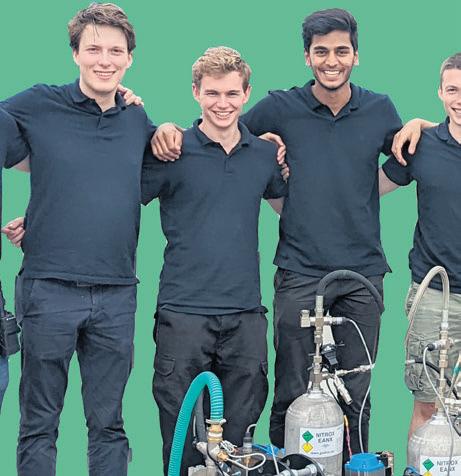

120 to their introductory lecture.
Since its conception in 2006, the society has been responsible for four major projects, each with varying degrees of success. In 2017, CUSF launched Martlet III in Nevada. Unfortunately, the rocket motor – the only o -the-shelf component – exploded, leaving behind only the rocket dart. But, as Barty informs us, failing is “natural and normal and part of the process’. e society fought back, and in 2019 designed the Pulsar engine, the largest nitrous oxide hybrid ever red in the UK.
e society is generously supported by the Department of Engineering “without too many strings attached” and has a roster of sponsors and donors supporting their work. While the society had originally aimed to launch rockets to space using a budget of only £1000, getting space-rated components can be expensive. Barty remarked that “you
could sell a kidney” for some highly sought-after equipment, like rocket valves. Nowadays, the society has a greater budget at its disposal, thanks to the external support. For many sponsors, supporting CU Space ight brings a great deal of publicity and represents a valuable training ground for young engineers to enter the space industry.

Now having scrapped Martlet IV, a rocket planned to reach 20 km, the budding engineers at CU Space ight decided to go back to their roots, and seek to achieve their original goal.

Enter Gri n I.


CU Space ight was founded with one main goal: launch a rocket into space


is single-stage rocket aspires to reach around 150km, crossing the edge of space in doing so. Barty tells us that the society is making “good progress’”with its development, and are provisionally testing its bipropellant engine White Dwarf, running on Nitrous Oxide and IPA (Isopropyl alcohol). is is a scaled-down version of the engine White Giant, which they plan to design and manufacture to fuel Gri n I.
ough the team plans to launch Grifn I in 2024, “integrating the rocket engine into the overall rocket design is a bigger challenge.” Both co-presidents explain to us how there is a back-and-forth design process, and that there are

big possibilities of facing multiple setbacks. But even if Abhi and Barty feel as though they are doing “another degree’s worth of work”, they don’t feel they are representative of society’s hardest workers. “People put their whole lives into this” they say.
Abhi and Barty tell us that the society runs almost entirely self-su ciently within the student body, compared to other similar initiatives at universities like Imperial. “ ere is a great understanding” that building a rocket is hard, said Barty, particularly when there are very visible failures from organisations like NASA and SpaceX. However, despite the numerous sponsors, Abhi urges us that the “pressure is more from our side in that we want to achieve as much as we can”.
Alumni of CU Space ight go on to achieve great things. Barty commented on two urban myths circulating within the society. After gaining experience from building rockets in CU Space ight, students are often dispersed throughout the space agency. One rumour ying around is that 90% of the sta of a company that tests rocket engines consists of Space ight alumni. Another tale involves Lars Blackmore’s membership in the society. He subsequently went on to work at SpaceX, and the code from his PhD has enabled the propulsive landing control for FalconX.
Barty and Abhi gave a tour of the equipment and we even got to hold the Aquila rocket. Upon seeing rsthand the tireless dedication the students of CU Space ight demonstrate, it wouldn’t be presumptuous to say that as the society continues to hit those milestones, their energies will inevitably launch them to success, and hopefully become the rst European student team to reach space.
Quick- re Round:
Musk, Branson or Bezos?

Abhi: ey’d all get you cancelled





Barty: Can we choose a fourth? Branson by process of elimination
e engineering department canteen has some weird and wonderful food. What is your favourite thing to eat?
Barty: I can deal with the apjack
Abhi: the fruit scone.
Barty: why? Have you been to the GP? What possessed you?
Abhi: I had never tried a scone before!
If Elon Musk was a biscuit, what biscuit would he be?
Abhi: Can you imagine a cracker with marmite on it?
Worst engineering stereotype?


Abhi: e worst engineering stereotype is that people don’t know how to socialise… but I also think it is the most true Barty: the depths of some engineers’ anti-socialness is shocking

18 Friday 3rd February 2023 Science
❝
❠
▲ CU SPACEFLIGHT
▲ FLOURISH CHART CREATED BY ESMÉ KENNEY
vulture.
▶LIFESTYLE AUNTIE MADDY TRIES THE UL TEA ROOM∙ 20
▶FILM & TV

THE LARGEST STUDENT FILM FESTIVAL ∙ 25
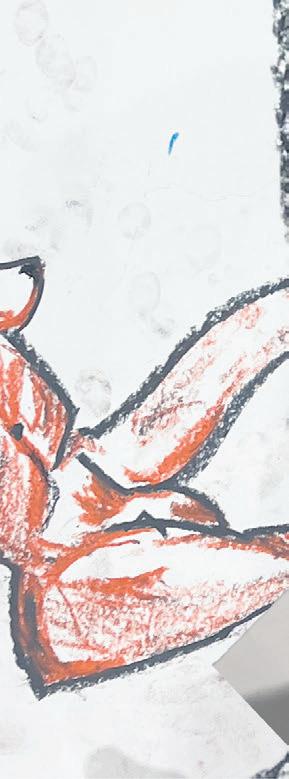
▶THEATRE ON COMMUNITIES OVER CAREERS ∙ 28
Interviewing involves a lot of things: a sharp mind, a knack for asking questions, a keen ear. However, so rarely does it involve helping your interviewee chop up carrots for dinner, which incidentally is what I found myself doing with Lily B- omas.
ough Lily is a brilliant chef, cooking us a fantastic vegetarian meal in a student kitchen, she’s best known around Cambridge as a second-year Architecture student by day and a life drawing model by night. She’s been

life modelling since before coming to Cambridge, having been introduced to it by a friend, and now regularly models at various life drawing evenings.
After a few na questions such as: “Does it get cold?” (apparently it does not; Christ’s College, where sessions take place, has a space heater), we get down to chatting about what it’s like being both an artist and a model, and how the two are linked. Lily is full of praise for her fellow models. “I’m always just admiring,” she says. “It’s not a thing of: ‘Oh wow, this person is ridiculously gorgeous!’ It’s more about the way the shadows are falling, the way their esh moves, the muscles, the skeleton, and how that’s beautiful.”
I ask about how she nds modelling, and if she thinks her experience of seeing models is the same as how other people see her. “When you’re a queer person, there’s that history of being told that your body is either a vessel for attack on other people or is a fetish, and in a way it’s just really nice to model because you realise that you’re just being admired.” She continues: “It’s weird because you’re being objecti ed in the most fundamental way, but that whole aspect of being naked falls away. You’re just being viewed as a series of shapes. It’s freeing.”
in the news, and the pressures to conform as a trans woman. She talks about her anxiety regarding passing: “I’m constantly aware of my body and asking: ‘Am I going to be attacked?’ every time I leave the house,” (as well as the general rise in transphobia over the past few years, especially regarding remarks by several in uential gures on social media.)


With that in mind, I wonder out loud about what it’s like to model as a trans woman in the midst of all of this. She laughs as she tells me how “everything” is out when you model...
It’s the neutrality that comes with life drawing that appeals to Lily, especially when looking at the recent onslaught of transphobia on social media and Continued on page 22 ▶









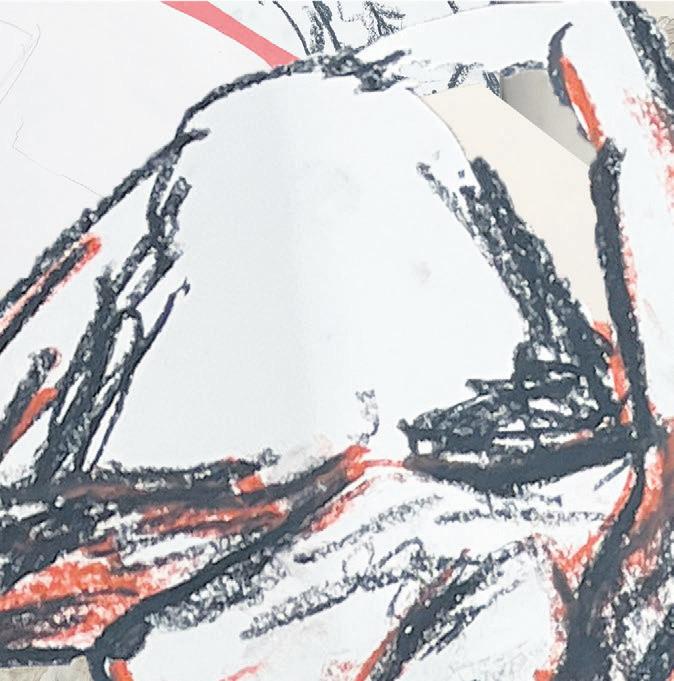

Friday 3rd February 2023 19
Emily Lawson-Todd
‘My body is not a weapon’: Being trans and a life model
▲ PHOTOS BY LILY BURGE-THOMAS
Spilling the tea on the ULTea Room
Agony Aunt Maddy Sanderson takes a break from solving your problems to investigate the UL Tea Room

Humanity has come far in the years since civilisation began. A recent win was the widespread success of the Covid vaccine. e moon landing was pretty big too, I guess. But just last week these things were blown out of the water when I got up close and personal with one of the biggest thrills of the modern age. Forget Junction. Forget Glasto. We’re taking a trip to
the University Library Tea Room, reopened 9th January after its year(s) of rest and relaxation when it was closed during the pandemic. And about time, too – for too long has the secret under-desk sandwich-scarfer had to su er in (literal) silence. Easter may be months away, but it looks like we’ve already got ourselves one hell of a resurrection.
I’d ploughed through a bumper bag of Sainsbury’s own-brand multipack crisps about 15 minutes before volunteering to trot over to
the UL, and while I’m no stranger to a second/third/ fourth lunch, I thought that, for safety’s sake, I might need to call for backup. So naturally, I ew in the special forces (enter: Lily and Joe). I’m also vegan, so thought it might be wise to bring in someone not quite as gastronomically challenged as myself to cover the tea room in all its blazing glory. ings got o to a rocky start when I was immediately deemed a security threat upon entry to the library, caught red-handed with my hefty black tote bag swinging on my shoulder like I was still strutting up and down Sidgwick Site without a care in the world. Rookie mistake. Come on, this isn’t the bleeding ARC Cafe – this is the University Library Tea Room! And to add insult to injury, to my great surprise I found no shining ribbon for me to cut waiting at its entrance. Still, after turning the corner, all was immediately forgiven. Picture a scene of light cascading in through high rectangular windows, illuminating the canteen below and bathing its patrons, perched attentively over a book or a thick wedge of cake, in rays of golden January sun. e sounds of soft clinks of glass and porcelain and the low, rumbling roast of the co ee machine oat like sweet arias up to its high ceiling, drawing me in and towards the counter.
e food situation seems to be predominantly self-service – aside from hot food, and I presume the soup of the day (intrusive thoughts did, admittedly, beckon me towards the great vat, goading me to plunge my bare hands into the boiling slop) – which, if like me, you’re
terminally uncoordinated, can at rst appear more than a little daunting. But have no fear: there’s a team of more-than-amiable sta on hand should you stumble in your e orts to nab the fateful last scone, and who, when they’re not whipping up some premium cooked delights, also make a pretty good co ee. Lily bought a red velvet cookie and Joe a sausage roll, which came with free salad and crisps. For myself, I nabbed a Jammy Dodger blondie. And of course, all of us bought a co ee. I was set back £6.20, which, in this economy, did make me wince just a little. But let’s face it: there’s a cost of living crisis; with the rest of the country struggling to keep its head above water – why would a random tea room in Cambridgeshire be shown any extra mercy? You’d spend more money on a Wednesday Revs ticket on average, and at least the UL Tea Room won’t leave you with a raging hangover, burst eardrums and a renewed sense of self-loathing you didn’t think was quite possible this early on in the term.
As Joe’s sausage roll is ready to be taken out of the oven, the machine begins to beep in a cadence not too dissimilar to that of the oven we had when I worked in my local Subway, inducing a series of unpleasant ashbacks that momentarily distracted me from the big angry “DECLINED” plastered across the screen after I tap the card machine. As expected, the venue was bursting when we arrived, so, nancial di culties (temporarily) resolved, our merry band had to brie y hover around one of the larger tables like eager vultures. But our patience soon paid o . e Jammy Dodger blondie, although so dense it would put most neutron stars to shame, was so soft, warm and jammy that it (almost) made me believe in love again, and with Lily happily working her way through the cookie and Joe through his fragrant, herby sausage roll – which, in his opinion, had the perfect pastry to sausage ratio, an extremely rare occurrence
and pleasantly surprising – it’s safe to say that the food in the tea room gets a mega thumbs up. I noticed Joe’s crisps looked a little small. “Bottom of the bag”, he suspected. Still, it was hardly a
bother. We did arrive pretty late, and what utter madman would open a whole new bag of crisps 20 minutes from closing?
It’s di cult for me to imagine going on a date here (Any takers? Please? Please?), but a cute coffee hang with friends? Sure thing. Just be wary of the occasional pass-agg tutting from fellow cafe-dwellers should the conversation reach over ten decibels. Nonetheless, the atmosphere is far from dismal. In fact, Joe described the ambience as a “general murmur”, which, for a library tea room – a space in which both work and play can, and should, collide – is about the best you can hope for. ere’s also a water cooler and a bookshelf at the back, near the intense plush comfort of the sofa square (if not a tad socially awkward, should you make eye contact with the person opposite), so you can spend all day chillin’ in the tea room to your heart’s content. I can’t promise you’ll get any more work done in here than in the austere hush of the main reading rooms, or the desolate emptiness of the upstairs stacks (literally the Cambridge University backrooms), but when you’re mid essay crisis and looking for a place to drown/gorge your sorrows away, there’ll always be a place at the table for you.
Hot takes on hot drinks



e UL Tea Room
e UL Tea Room allows you to take a deep breath in the middle of a long, tiring day without even leaving the library. Two minutes from Sidgwick and zero minutes from the University Library, it is a pocket of sound within the silence, a bubble of good vibes amidst the oppressive silence of the stacks. Not as expensive as you might expect, and well worth it for a much needed break.
Esther Arthurson, Lifestyle Editor
Harvey's Co ee House
I don't know who Harvey is, but I do know where he came from: he slipped on a cloud in heaven, landed at the foot of Caius freshers' accomodation, and blessed us with his co ee house. When I rst set foot in his godsend of a cafe one rainy day, it felt like coming home. When the waitress o ered to heat up my pastry, I think I ascended. ere's nothing quite like drudging down a muddy path to the blanketed armchairs of Harvey's. I just wish there was more space.
Hannah Gillott, Vulture Editor
Sidgwick Buttery
After a whole year of gaslighting myself into believing that ARC co ee is even remotely ingestible, imagine my delight when I heard there was a new place to get my ca eine x! Au contraire, dear reader. It turns out that Sidgwick buttery co ee is simultaneously strong enough to give you shakes all day, rendering writing an essay impossible and yet not strong enough to stop me from falling asleep in my lectures. And it's extortionate!
Emily Lawson-Todd, Arts Editor
e ARC
















You know what I love? Shit co ee. You know what I love even more than shit co ee? Stained seating. So imagine how happy my fresher self was to waddle into the ARC Cafe and see my wildest dreams come true! Brimming with Sidge girlies (recently pro led in a Varsity photoshoot) and démodé dudes like myself, all looking for the sweet nectar of life, it never fails to disappoint with its mud splash it deceptively names 'co ee'.
Daniel Hilton, Vulture Editor
❝ ❠
Lifestyle
❝
❠
Easter may be months away, but it looks like we've already got ourselves one hell of a resurrection
❝
❝ ❠ ❝ ❠ ❝ ❠
A space where work and play can, and should, collide ❠
20 Vulture friday 3rd february 2023
▲ HANNAH GILLOTT
Know yself: Are personality tests enough?

Sarah Adegbite discusses the age-old urge to know ourselves

If you travel towards the heart of central Greece, wading your way through the ruins and rumbles of history, you might nd yourself atop the grand Mount Parnassus. ere, you can see the remains of the Temple of Apollo at Delphi, where it was said the Pythian oracle dwelt. It seems that, from our knowledge of ancient texts, carved onto a column outside the front façade of the temple were three inscriptions, recording aphorisms devised by the Seven Sages. But for the purposes of this article, I am mainly interested in one: "know thyself."

It seems that now, more than ever, we are obsessed with the art of knowing ourselves. People pay for in-depth psychoanalytic tests that determine how best they should approach everything from careers to relationships. Others avoid relationships altogether if 'the stars haven’t aligned’ and their horoscopes don’t match. Whole Instagram accounts are dedicated to enneagram types and the common problems they’ll encounter. We assess and categorise; we divide and label. Perhaps this is the human instinct to nd patterns and groups at work on a personal and collective level. In many ways, though, the Delphic injunction to “know thyself”, written so many years ago, reminds us that this pursuit of personality isn’t something unique to our day and age.
Confession: I myself am guilty of relying a bit too heavily on the Myers-Briggs Type Indicator (MBTI) test to tell me what I should know about myself. It assesses an individual across four key
‘type indicators’: extraverted or introverted? Intuitive or sensing? inking or feeling? Judging or perceiving? According to the combination of your letters, you might be assigned a character type, like ‘Mediator’, or ‘Defender’. Since taking the test in 2018, I have been consistently characterised as a Turbulent Protagonist: ENFJ-T – extraverted, intuitive, feeling and judging. When I rst read the personality description, I couldn’t believe how accurately it had described me. It was like someone was prying apart my brain and putting all my instincts and intuitions into neatly constructed sentences.







But it seems, more often than not, these personality tests are indicators not of who you are but who you narrate yourself to be. Look at the enneagram test, for instance, where you must rank yourself on a scale from strongly disagree to strongly agree in accordance with a variety of statements. One such reads: “I am more sensitive than most people; sometimes the world just seems too harsh.” A fairly re ective person could make a pretty good stab at a self-assessment, but at a deeper level that little phrase – “than

most people” – requires you not only to know yourself, but to know the general spectrum of human personality to which you are comparing yourself. What level of sensitivity is ‘average’ in our generaDon’t get me wrong, I don’t think tests like these are bad. In fact, the questions they ask are exactly the kind of probes that get you to think just that bit more deeply about your emotional, social composition, about the impact you have on the world. e problem is when the categories that result become prescriptive, instead of descriptive. I was pretty sure I was an introvert until coming to university. I really enjoyed people’s company, liked speaking to big groups of people, and didn’t mind making small talk too much. But I was so aware of the space and time I needed to reboot, recharge. en I arrived among these towering spires and cobbled streets. Something about starting afresh in a new place seemed to suppress that introversion. All of a sudden, I was drawing energy from social events, taking pride in a chock-a-block calendar, de ning myself as an extravert to the world, and myself.
And those tests didn’t help. But coming into a new term, I’ve found myself again treasuring alone time. Burrowing away at the corner of the AMES library, or tucked up in bed with a bowl of grapes and a Zadie Smith novel. It was the continual de nition of myself as an extravert that had perhaps precluded me even realising that I would appreciate more alone time than I was getting.
What I’m trying to say, I think, is something that has already been said thousands of years before. We should know ourselves, but that doesn’t mean zipping ourselves up into the binary of introvert or extravert, or allowing what a test says to become a self-ful lling prophecy. To know yourself is to know that you change, that you’re a contradiction, that perhaps Whitman was unusually astute in declaring that: “I contain multitudes”. e best way we can know ourselves is to grasp that we, as loved, created beings, are ourselves known. It seems St Paul had it right in his rst letter to the Corinthians: “For now we see only a re ection as in a mirror; then we shall see face to face. Now I know in part; then I shall know fully, even as I am fully known.” Perhaps, then, to “know thyself” is not so important as to be “fully known”, but can we ever plumb the depths of that knowledge on this side of eternity? Who knows? We might just have to wait and see.
Lifestyle
Vulture 21 friday 3rd february 2023 J. S. Wilson & Son Bookbinders Ltd Cambridge Established 1830 Thesis Binding Conservation Leather Binding Journal Binding Tel (01223) 212420 www.jswilsonandson.co.uk
HANNAH CASTLE ▲
Arts
In defence of the Sidgwick sights
Arts writer (and Sidgwick apologist) Anna Wythe examines the site's Brutalist beauty and concrete quirks

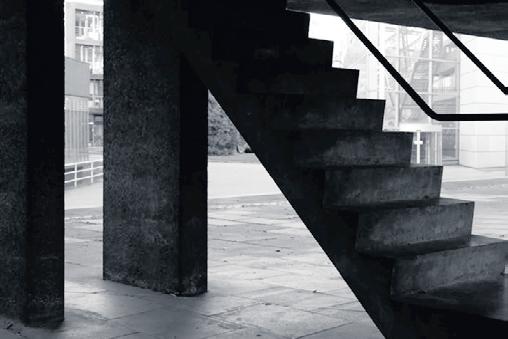
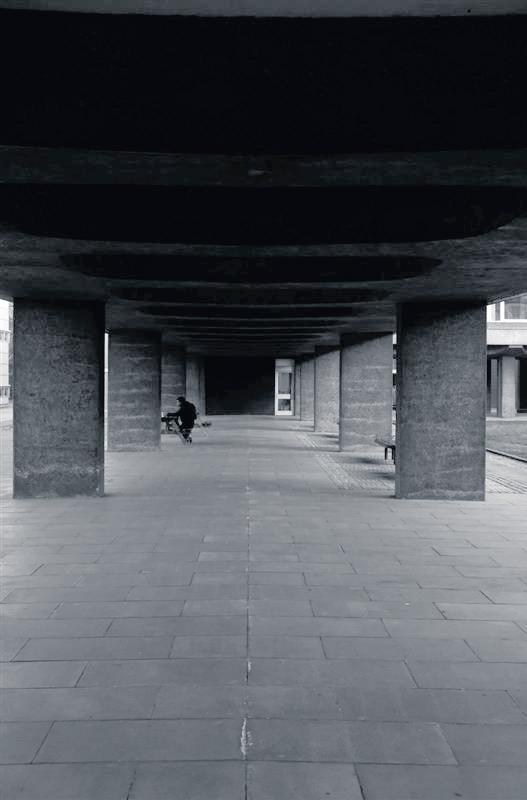
One of the very few things I miss about being a teenager is drinking in the park after dark. It’s not the cheap wine or the inevitable disappointment; it’s the strange shadowy silhouettes of a playground suddenly decontextualised. When no one thinks to play on them, the climbing frames and seesaws become as quasi-artistic and lonely as the teenagers drinking in their shadows.
A walk through Sidgwick Site late in the evening recently reminded me of that atmosphere. Stripped of schedules and Cambridge glitterati, it becomes mere shapes and lines. Especially in the rain, it’s a wonderful place: not comforting but beautiful in a cold, geometrical way.

I realise I’m wading against the tide of public opinion when I describe Sidgwick as beautiful.
So often the physical space is decried as ugly, industrial and hellish, but I won’t contradict anyone’s ‘vibes’. e beauty of it is for me at 3am, not public discourse.
I do think, though, that the architecture of Sidgwick is more interesting and more t-forpurpose than it is sometimes given credit for. e only caveat for this claim is that everything I know about architecture comes from Wikipedia and BBC documentaries.
My true love on Sidgwick is the raised MMLL faculty building. It is, for want of better words,
and “unnatural.” Perhaps the UFO conspiracies about ancient monuments made their way into the twentieth century. ere certainly seems to be a sense that giant man-made structures are somehow uncanny and disturbing. But what causes this discomfort?


At the heart of Brutalism, there is the idea of truth. It aims to take away the decoration, the ornament. It shows honestly the materials used in construction (famously, reinforced concrete) and
an architecture unique through its nakedness, not its clothes: architecture sans skinny scarf, sans trench coat.

Although the Raised Faculty Building is a restrained example of Brutalism, it still holds that suggestion of nakedness. It is the opposite of domestic space. e scale precludes intimacy. e exposed design precludes privacy. Perhaps this is what disturbs us. Perhaps it is the lack of escapism in this kind of architecture. You look at the
Cont. from cover

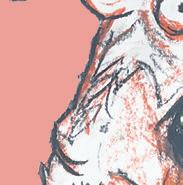

...with “50 pairs of eyes watching you and drawing”. Yet it is in these moments that Lily nds joy. “To nd myself in a room with people, showing my entire body, and yet just being drawn, I have this realisation that my body is not a weapon,” she says. “It’s in that moment when you’re standing there, you realise that the stu people write in e Daily Mail isn’t what most people think. When I’m there, all that hate and internalised self-hatred fades away.”
concrete and it looks right back at you. So too, there is none of the overwhelming harmony you might nd in the King’s College Chapel ceiling or the Wren Library. Brutalism doesn’t promise a coherent ordering of the universe. If there’s a spiritualism to it, it comes from what a human mind will do staring at a blank wall.
Personally, I wouldn’t object if the whole of Sidgwick Site was poured from a single concrete mould. Nevertheless, the south side breaks open into something very di erent. e buildings are more postmodern, or at least more open to reference and representation. ey include the spiral staircase to heaven (the Divinity Faculty), the corporate cathedral (the Law Faculty), and most famously, the History Faculty designed by James Stirling.
However, it wasn’t always so easy. We discuss growing up queer, and she tells me that when she started modelling she was “quite tense and stressed”, holding poses that were painful for extended periods of time. “I had this quite self-deprecating stance towards myself that came from a history of exploring who I am.” But her recent creative works, from life modelling to working on 52 Monologues for Young Transsexuals, have been celebratory. “ roughout all of it,” she says, smiling, “it’s been an exploration of what my body is and what my body does.” It’s clear to see that now this exploration is far more positive.
Her favourite part of the life drawing sessions, Lily tells me, is when it nishes. Not because you get to leave the pose you’ve been holding for 20 minutes, but because you get to “take pictures of all of the work and go to your friends and be like: ‘Oh my god, look how attering this drawing is!’” When I probe about whether she has any particularly outrageous stories, she laughs and tells me about a time where she’d come into a session without getting time to clean. “I was posing and I was just thinking: ‘What if I haven’t wiped properly?’ and obviously I couldn’t go move and check and be like: ‘Sorry guys, have I wiped?’ It’s something I am constantly paranoid about!”
I ask her whether she’s got any up-and-coming projects in the works.
wacky as hell. Part of the original 1950s Sidgwick, the Raised Faculty Building is the work of the Casson Conder company, masterminds of the Northern half of the site, including the Economics Faculty and Lady Margaret Hall. Casson Conder brought a distinctly Brutalist approach to these early constructions. e reinforced concrete pilotis are straight out of the Le Corbusier playbook, which is to say, they refer back to the early purist vision for Brutalism. e strange corridor spaces beneath the building have the sense of a tunnel even in daylight. It’s Fritz Lang meets Joy Division. It’s cool.
I nd it curious that people manage to describe Brutalist architecture as both “inhuman”
the mechanisms of design (like the pilotis). It isn’t necessarily, however, the faceless architecture of anonymous apartment buildings. As Jonathan Meades informed me via YouTube, truly brutalist buildings are made by pouring concrete moulds on-site, a technique which gives architects more freedom to create new and di erent shapes. It is
In breaking with the austerity of Brutalism, Stirling also broke with its functionality. Leaks and temperature problems have plagued the History Faculty building since the 60s. Indeed, I can testify that it remains to this day unable to keep its occupants warm in the winter. As Wikipedia so aptly observes, “Although the building was admired by students of architecture, it is less well regarded by those who have to work in it.”
Whatever the joys of critiquing Sidgwick south side, it reveals a fascinating fragmentation of design in a very compact space. If modern architecture is often criticised for monotony, the buildings on Sidgwick retain particularity. I like the mishmash that results. Academia is no longer one nation under God, and there’s no point in giving it an arti cial harmony through architecture. Sidgwick is perhaps a harsh visual environment, but it’s not an inhuman one. It makes us uncomfortable in all the right ways and it’s beautiful at 3am.
She tells me about an upcoming installation that I am “sworn to secrecy” about, as well as her recent brainwave of starting a trans-safe swim space. And of course, she’s still life modelling at ArcSoc, which I vow to come to as we nish up the rest of our meal. As for now? She’s continuing to “celebrate trans voices”.
❝
You look at the concrete and it looks right back at you ❞
❝ Beautiful in a cold, geometrical way
❞
▲The cold geometry of Sidgwick (ALL PHOTOS BY NATHAN WESTHEAD)
LILY BURGETHOMAS▶
❝
22 Vulture friday 3rd february 2023
Sidgwick is perhaps a harsh
visual environment, but
it’s
not an inhuman one
❞
e lowdown on the zine scene
Arts Editor Emily Lawson-Todd rounds up the zines currently accepting submissions
Cambridge Girl Talk
Social Media: @cambridgegirltalk
Next Issue: N/A - Continuous
Deadline: N/A - Continuous
If feminism is your thing but deadlines aren't, then Girl Talk is perfect for you! Watch out for their weekly commisions on a variety of topics, from topical issues to more personal re ective pieces. ey also have regular socials, which are a fantastic way to meet like minded creatives and share ideas.
Catharine Zine
Social Media: @catharinezine
Next Issue: “Re ections”
Deadline: 12 February
Fresh o the success of their rst issue, “Power”, which saw a variety of contributions, from interviews to multimedia artwork, this feminist zine, founded in St Catharine’s College, is back with their second issue, “Re ections”. Stuck for contribution ideas?
Rock up to one of their “candlelit creatives” for atmospheric brainstorming sessions. If the sound of writing by candlelight while looking at old tarot cards and listening to Taylor Swift appeals to you, then this is the perfect zine.
Typewriter Zine
Social Media: @typewriterzine
Next Issue: “Characters”
Deadline: 15 February
Its name both a reference to the infamous accommodation building and the fact that a real typewriter is involved in publication, this Christ’s-based zine is one of Cambridge’s newest o erings to the scene. Check them out for quirky and intriguing prompt ideas, ranging from Aristotle quotes and Japanese Noh masks to David Bowie and Virginia Woolf. Watch this space for their rst ever issue.
CANVAS Zine
Social Media: @canvaszinecambridge
Next Issue: “CANVAS IV”
Deadline: 18 February
If themes and prompts are less your thing, CANVAS is the zine to let your imagination really run wild. Created in 2020 as a “blank canvas ” for student art and writing, it thrives on its lack of theme. Its last issue featured, among many other things, erotic pottery, a cut-up poem, an essay on Prince and gender, and a Gulliver's Travels-inspired short story about Je Bezos and an ant.
Emily: Starting a zine is to humanities girls what starting a podcast is to nance bros. Maybe this slightly scathing remark is based on my own bitter and fruitless experience as a rst year student attempting to set up a zine on my own with very little idea about A: what a zine actually is, and B: how to publish, edit, or even select a theme. Alas, it was doomed from the start, left to be a pile of half-written ramblings and some “edgy” vmagazine cutouts. However, unlike the nance bro podcast venture, the humble zine takes (as seen from my own poor attempt) some real determination and e ort, is much, much more visually appealing, and usually is not trying to get you to invest in crypto or to embrace the sigma male grindset by only eating raw beef.
VsAnna: Zines are the home of creatures that would otherwise have spent their lives in shoeboxes and Word docs. How strange to see the little clump of words that was so carefully hidden suddenly displayed on glossy pages! ere are many names for making art: procrastinating, moping, insomnia. Zines are kind enough to remind us that our scribblings might be a cultural endeavour that links us to other human beings. When you nd something you love in a Cambridge zine, there’s the shock of knowing that its maker isn’t buried in a distant land, but across the room from you at the launch party, or at least somewhere in this murky old town.
Weighing up the pros and cons of kilo sales

Ifeel like I can’t go on Facebook these days for a painful scroll down Camfess without seeing at least one kilo sale ad peerpressuring me into announcing to all my friends that I am in fact “interested”. Where there was once just one brand promising weight-based bargains, its existence has spawned an endless amount of copy varieties. So why has this phenomenon grown so popular?
For anybody who’s been living under a synthetic, mass-produced rock for the past few years, a kilo sale is a second-hand shopping experience where the price of your clothes is determined by their weight. Once you’ve spent the good part of an otherwise productive afternoon rummaging through ratty Adidas T-shirts and questionably patterned blouses in your local church or town hall, you then weigh your nal haul to nd out its cost.
Taking a step back, it seems rather a strange system. Although the idea of more clothes costing more makes sense, clothes obviously weigh varying amounts based on item, regardless of quality. You can practically get ten lightweight blouses for the same price as one leather jacket. However, it’s also fair to say that heavier items such as jeans, jackets, and jumpers do tend to be more expensive than things like T-shirts in non-weight-based shops anyway. But I’m sure there are a fair few people who have either been massively robbed or who have made an immense bargain from this concept. At the end of the day, it’s up to the consumer to be smart.
Talking to some students at one Cambridge kilo sale, one of them said they come to these
sales “for the brands. Because it’s done by weight – a T-shirt like Ralph Lauren in a charity shop might be marked up, but at a kilo sale it won’t matter.” Obviously, like all second-hand shopping, there is an element of luck. Sometimes there’s just a good o ering, and sometimes there’s not. A pro tip is to get there as early as possible, but my top tip is to pick the right kilo sale brand. e rst kilo sale I went to in Cambridge was amazing. I got a slip dress, a maxi skirt, a jumper – everything slotted perfectly into my Sidge girly wardrobe. I’m not going to name any names, but my second experience with a different brand left me surrounded by stained 80s grandma blouses and sports T-shirts that looked like they’d been shed straight out of a ten-yearold boy’s laundry basket.
of the commercial world operates. Surely you make money from your product, not from giving people the opportunity to purchase it. In making people pay entry, it makes you feel like you’re paying for the experience itself – something to romanticise into an “event” with your friends (despite their often dingy underwhelming-ness). ere’s a reason you’re coming here instead of getting caught in an eBay bidding war.
charity shops” it is “a day out” they can enjoy with their friends.



I did end up buying a turtleneck though. Did I really need it? No. Did I feel the need to buy it because I’d already paid a fee to get through the door? Yes. Many kilo sales insist on having a standard entry price to cover the basic cost of hosting the event. But that’s not how the rest
Although I understand where the organisers are coming from, entry fees also take away some of their accountability. ey could ll the hall with the ugliest clothes in existence but they’re still going to take in cash. Sure, they might not make a pro t this way, but it just seems a bit unfair that you can spend money at a sale and still walk out with nothing. Which is another twist in this tactic. Despite how illogical it is, something about spending money to get into the sale pressures you into at least buying something. Yeah, you’re now spending £6 instead of just the £2 entry fee for a £4 dress, but at least you’re not just spending £2 on the feeling of disappointment and wasted time. e students I spoke to said although this entry fee is “annoying”, ultimately “it’s not too bad.” Despite the fact they don’t “prefer kilo sales to
In all honesty, I’ve found myself disappointed by most of the kilo sales I’ve attended. And I really don’t think they’re worth it unless you ensure you’re going to the good ones. e lack of changing rooms, the overwhelming amount of stu , and the entry fee just make the whole thing a hassle. Yes, the right brand on the right day at the right time can sometimes provide you with hidden gems and a great time, but more often than not you’re better o just hitting up your local charity shops.
▼It's giving grandma-core (ISABEL DEMPSEY)
Arts
❝
At least you're not spending £2 on the feeling of wasted time alone ❞
Isabel Dempsey decides whether this second-hand shopping sensation is really worth the hype
Vulture 23 friday 3rd february 2023
To zine or not to zine?
Fashion

A de nitive ranking of the Grafton charity shops






If you're looking for sustainable pieces that won't break the bank, Eden Keily- urstain has you covered






















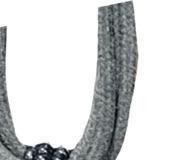





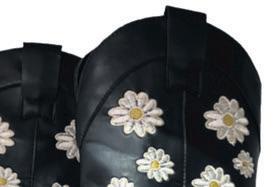
Mind
e proximity of spelling of Mind to “mid” feels quite tting in this context. But don’t be fooled, mid does not necessarily mean bad. Mind is an average, but solid all-rounder that embodies all that you would expect from your local trusty charity shop. e racks could have been fuller, but contained some great vintage high street pieces that have at least 20 years of wear left in them. e pricing is also fairly respectable for Cambridge and I managed to secure some pink linen trousers for £3.50. A job well done.
Score = 3 / 5
Arthur Rank, Cancer Research, and Sense

Many of us, from those who fancy themselves expert bargain- nders, to those simply looking for a cheap costume to wear to ARCSOC, have ventured down to Burleigh Street at some point, home to the coveted “Grafton charity shops”. More dedicated shoppers may traipse around every shop that Grafton has to o er, but Cambridge students are busy and your supervision essay on Foucault isn’t going to write itself. For the more time-starved among us, the Varsity Fashion team have visited and (very scientically) ranked every Grafton charity shop so you don’t have to waste your precious time icking through too many Aztec-print leggings.
British Heart Foundation
At the top of the Grafton food chain stands the small but mighty British Heart Foundation. BHF is the rst shop you arrive at if you’re walking from the Grafton Centre so is absolutely a necessary stop. A quite frankly impressive volume of clothes is stu ed into quite a small space. While this can feel a little overwhelming, it does mean your odds of scoring a gem are increased. e lack of an operational changing room and mediocre men’s section lets BHF down a little, but the sheer range and style means it trumps the rest.
Score = 4.5 / 5
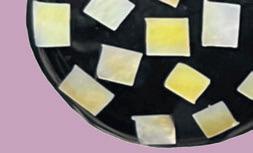
Scope
Chances are if you’ve made the pilgrimage to Grafton you’ve visited the explosion of colour that is Scope. e density of platform heels is probably among






credibly groovy
home section upstairs that is worth a visit, and the prices generally aren’t too bad for Cambridge.
Score = 4 / 5
RSPCA
I’ve chosen to lump these shops together as they all share one thing in common: they are distinctly forgettable. Arthur Rank loses points for the apparent desire to recreate the “Lush experience” by having the most potent fruity air freshener to ever grace a charity shop. ey also had an activewear section for any “new year new me” sentiments you might be harbouring. Sense does have some reasonable pricing, but all of the shops had quite a limited range, meaning it was hard to unearth any great nds.
Score = 2 / 5
British Red Cross
can feel like a poor deal if the clothing is from fast fashion brands such as ASOS. Scope isn’t the place where you will score the vintage coat of your dreams, but the contemporary range still has many high quality pieces on o er, making it well worth a look.








Score = 4 / 5
Oxfam
On our afternoon of rigorous charity shop research, Oxfam was closed by the time we arrived at the incredibly early time of 4pm, docking it down from second place. is shop is a bit of an elusive beast in terms of opening hours, but when it is open you can expect to be met by two oors of secondhand delights, beautifully organised by colour. ere’s a large
On paper RSPCA is certainly not one of the strongest candidates in Grafton. e range of clothing is fairly poor and ill-organised, and the combination of the incredibly shiny oor and white lighting makes you feel like you’re at the dentist (phobics beware). However, there is something inexplicably vibey about the RSPCA. Maybe it’s the very chatty sta or disproportionate amount of dog memorabilia. Or maybe it’s the galaxy mermaid themed window display. Regardless, the atmosphere is excellent and I refuse to elaborate further.
Score = 3.5 / 5


















































Honestly, don’t bother. As a charity-shopper with a long and dedicated career, I am yet to nd anything even remotely nice in this shop. e range is very sparse, and is a no-go for those wanting to nd masculine pieces. e 1940s music did add a certain jenesais but not one that anyone was asking for. I also came across a Zara shirt for £30, which was a little confusing. ere’s a complementary furniture shop across the street which sells exclusively bed frames, Adam Sandler DVDs, and “Prosecco o’clock” wall art. A fun visit, but avoid if your time is limited.
Score = 1 / 5
24 Vulture friday 3rd february 2023
▲PHOTOS BY EDEN KEILYTHURSTAIN
Watersprite Film Festival is an unmissable student-led e ort


Inês Goes-Marlière sits down with this year's Watersprite festival director and head of communications to discuss what makes the festival so special
“I didn’t actually know anything about Watersprite in my rst and second year”, Charlotte Matheson, the festival’s director confesses, when I sit down with her and head of communications Zeb Goriely in Harvey’s Co ee House. “Even though for a long time it’s been the biggest international screen festival in the UK, and I’m interested in lm. Even now, I speak to my friends, and they don’t know it happens in Cambridge every year”.
is year, the Watersprite Film Festival will run between the 3rd and 5th of March. It includes everything from the screening of 27 nominated student lms from around the world, to screenwriting workshops, industry talks and more. All events are organised by committees of student volunteers from Anglia Ruskin and Cambridge, and aim to give people aged 16-30 an opportunity to engage collaboratively with lm, both in person and online.
is hybrid format, maintained by the festival post-pandemic, has signi cantly boosted its global pro le; “although it makes it more difcult to run, because all of our events need to be live-streamed, it hugely increases the reach of the festival”. Zeb informs me that it’s probably here to stay, because the festival’s “main charitable goal is in part to widen access on how to break into the lm industry. Before the hybridi-
sation, we were mainly reaching people local to Cambridge, whereas now people can watch it all over the world”.
Expansion has seen the festival receive a record-breaking number of entries, from 106 countries, including a 40% increase from the
African continent, after their summer outreach programme. Charlotte explains that it consisted of “every head of department consulting the submissions map from the year before, and seeing which areas we weren’t getting submissions from. en, we would research ten lm institutions from those areas, and nd the email addresses of people that worked there so we could email them all individually. It worked; being attentive and personal with people goes a long way".
At a local level, this outreach e ort saw attention paid to strengthening the links between Cambridge and Anglia Ruskin, since Watersprite is an organisation uniquely formed of the two. Zeb tells me: “Most ARU students have never set foot in a Cambridge University building, and viceversa. I was talking to someone from Footlights, and they were complaining about how they can never get anyone to lm their shows when there’s a whole university next door with a whole lm department. Get in touch with them!”
Indeed, the collaborative nature of the festival is what makes it so special. Charlotte admits: “at points, I’ve asked myself, ‘why am I doing this? is is so huge and I’m in my nal year. I should be focusing. I don’t want to say something like it’s run on passion. But I think I know that this festival is so pure – not only in its showcasing of
Vulture Reviews: A character study of cosmic proportions in Todd Field's TÁR
Tár starts by – as it intends to continue with – o ering its audience a challenge. My screening was met with confused murmurs, laughter and even grunts of annoyance at the prolonged crawl of opening credits, acknowledging rst those usually relegated to the very end of the end credits, the catering sta , production units and assistant editors. Some might call it pretentious, but it strikes me as a thematically trenchant act of subterfuge from writer-director Todd Field. A pointed refusal to be branded as an all-conceiving, all-creating ‘auteur’. After all, to make and distribute art is, almost unavoidably, to collaborate. More often than not, the cults of personality that build around so-called individual ‘geniuses’ can lead to the subsuming, and even exploitation, of those at the bottom of the creative hierarchy.
e ‘genius’ in question here is the eponymous Lydia Tár, brought to life by Cate Blanchett. She is the esteemed maestro of the Berlin Philharmonic Orchestra who stands at the crowning point of a career that has seen her showered in accolades and a orded an illustrious reputation. Fittingly for a conductor, Tár navigates both her professional and personal life to an unwavering, precise tempo. at is, however, until scandal and rumours of sexual misconduct threaten to unravel her
seemingly perfect world.
Tár is a proudly di cult lm, dialogue-heavy and stubbornly reluctant to talk down to its audience. e unassuming viewer might become weary of long dinner table conversations about the intricacies of classical music, were it not for Blanchett’s utterly captivating turn in the lead role, which anchors the entire project. It’s a performance at once grandiose and painstakingly detailed, a blend of imperious hauteur and quiet vulnerability that arrests our gaze with the mere ick of a conductor’s baton. e lm is handsomely crafted, from Florian Ho meister’s stately cinematography, to the wonderful sound design that nds as much music in the banal as in Beethoven. But it’s all in service of Blanchett, and Field ensures that she is given the space she needs to shine.
Reliably audacious across the course of its almost three-hour runtime, Tár seems tailor-made to polarise. Lydia’s calls for a young student of colour to “sublimate” their identity in the face of an overwhelmingly white, male classical music canon has seen it lauded by right-wing ideologues on Twitter as a retort against ‘wokeness’. On the other hand, real-life conductor Marin Alsop has criticised the lm for apparently demonising the achievements of women in music, particularly those who identify as lesbian. Both risk simplifying Tár; Lydia’s femininity, sexuality
and even occupation are almost incidental – she stands in for any and all gures of authority who exploit their positions for sel sh gain. “Sublimate yourself” to the music, she might command –but the irony is not lost on us that what Tár really desires is for everyone in her life, be it her pupils or her wife (an excellent Nina Hoss), to sublimate to her as well.
When it comes to so-called ‘cancel culture’, the lm is level-headed but never equivocating. In latching onto condemnation of easily visible, individual acts of wrongdoing, do we risk ignoring systemic injustices that are harder to see, let alone call out? Does the invisibility that results from ‘cancellation’ impede true accountability?

Tár is interested in all these questions and more, yet never pretends that their answers are easy. Watching Field’s lm is to be constantly torn between di erent points of view, and to have your assumptions and sympathies challenged.
As the lm draws to a close, we still don’t really know how to feel about our central character.

e nal scene is not one to be spoiled, but is a biting turn of the screw that is bound to provoke a laugh – but, for better or for worse, might also bring with it pangs of bittersweet pity.
Love or loathe Lydia Tár – but when Blanchett steps up onto that conducting podium, piercing the faces of her players and the camera with that icy gaze, I challenge you to look away.
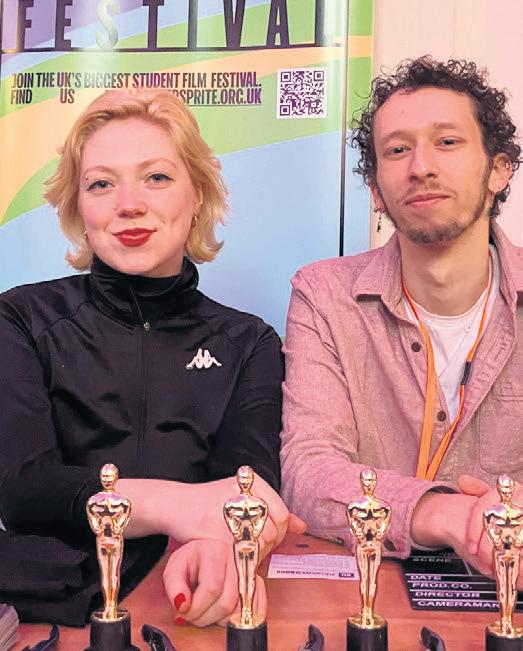
student lms untainted by the lm industry – but also it’s not run on money, but on people caring about lm, and things like our awards team sending out personal letters to the nominees around the world”. ere is a generous, independent spirit; “something inherently good about it that’s nice to channel your energy into”. ❝
In Zeb’s words: “It’s raw creativity. With student lms there’s no oversight, no guidelines; people just make what they want”; this is what makes student lms especially exciting. Charlotte adds: “ e fact that it’s run by students, that’s incredible. When you speak to people at other professional festivals (in paid positions), they’re always astounded at the number of lms we get through and judge fairly. It’s like, ‘how could these students do that?’”.
How to attend
e Festival’s events and screenings are also completely free! Anyone in this area, from the keen thesps and lm bu s interested in screen acting classes, to the rest of the general student population, has a huge opportunity to get some real insights into the lm industry through talks, masterclasses, workshops, Q&As and the chance to watch great student lms that have undergone a rigorous judging process.
e events will be held at the Old Divinity School in St John’s. Friday 3rd will be a day exclusively aimed at sixth formers, in partnership with BBC ree, so invite all the moody year 12 and 13 students you know! It will be strutted around three workshops: “How to Fund a Film”, “How to Make a Film” and “How to Distribute a Film”. Saturday 4th and Sunday 5th will be open to everyone. Get involved and take yourself to a screening, spot some celebrities, and try out some workshops – you never know, you just might become the next Sam Mendes.
In the words of Charlotte, “it’s all free, why wouldn’t you?”
ILLUSTRATIONS BY HANNAH GILLOTT
Film & TV
Cate Blanchett commands the screen in Todd Field's skin-crawling directorial comeback, writes Isaac Jackson
▲PHOTO BY WATERSPRITE PHOTOGRAPHER
With student films there's no oversight, no guidelines; people just make what they want ❞
Vulture 25 friday 3rd february 2023
‘No thank you,’ or yes please? This Charmless Term
Jacob Tucker returns with a searing review of Little Simz's new album
NO THANK YOU, the ifth studio album from UK rapper Little Simz, is a mixed bag. he highly acclaimed Sometimes I Might Be Introvert, released just over a year ago, now stands as an even clearer creative peak at this point in the artist’s career, having been favourably compared in structure and inventiveness to Kendrick Lamar’s To Pimp a Butterly. his latest album feels far more casual than its predecessor. Pejoratives such as ‘throwaway’ or ‘unnecessary’ may seem a little heartless, but after the thematic urgency of Sometimes, NO THANK YOU feels like a needless step back.
It has neither the conceptual strengths of Sometimes, nor the raw edge of 2019’s Grey Area, and does not bring anything new to the table. his does not mean that the album is bad; it is, in fact, one of the better hip-hop albums of the past year. In relation to the body of work created so far by Little Simz, however, it falls short. It has a relatively short runtime of 49:56, spread out over ten tracks; most of these tracks rely heavily on sampling–largely from soul; forgivably the most overt reference Simz makes to her inspiration from Kanye. Simz modiies these samples, modernising them, in efect, and sculpts her verses around them.
he stuttering sample on “Angel” starts the album of fairly well; it repeats throughout the song, forming a reliable blanket of sound around which Simz can write verses. Some more variation in instrumentation would have

been welcomed, especially considering that the lyrics here are rather weak: “hey don’t care if your mental is on the brink of somethin’ dark / As long as you’re cutting somebody’s payslip / And sendin’ their kids to private school in a spaceship”. he delivery is often lawed across the album; Simz enjoys employing a fairly restrained delivery which, on her other albums, was usually used to great efect, but here often comes across as unintentionally monotonous, even bordering on lazy.
Some bars also feel as though they could have done with a second take (listen closely to the line “What did I expect from those livin’ the corporate life?”, for instance), and the general implementation of rhyme is often obvious and forced enough to ruin the relevance of the words themselves.
“Gorilla” again has a great instrumental. he lyrics, however, often distract from this; the reference to Mac Miller, while no doubt wellintended, comes across as a little disingenuous.
“X” is perhaps the best track on the album: inally, the samples, low, and lyricism complement each other almost perfectly. “Heart On Fire”, however, is the irst track on which the instrumental feels somewhat lacking; it almost feels cheap. Perhaps this is an intentional choice, and a tacit reference to Simz’s past practices of creating music using MacBook plugins, but, as with the Mac Miller reference, intention can only carry the track so far. he inal two minutes of the track could
have been cut: they form a fairly inconsequential outro which, though pretty, largely begs to be skipped. “Sideways” and “Control” both feel largely unnecessary, primarily relying on their instrumentals, but not contributing much to the album in their own right.
he results are often impressive, but the formula is transparent. he album also lacks the thematic cohesion of previous works: it tries to be “about” too many diferent issues and, as a result, fails to say anything memorable at all. NO
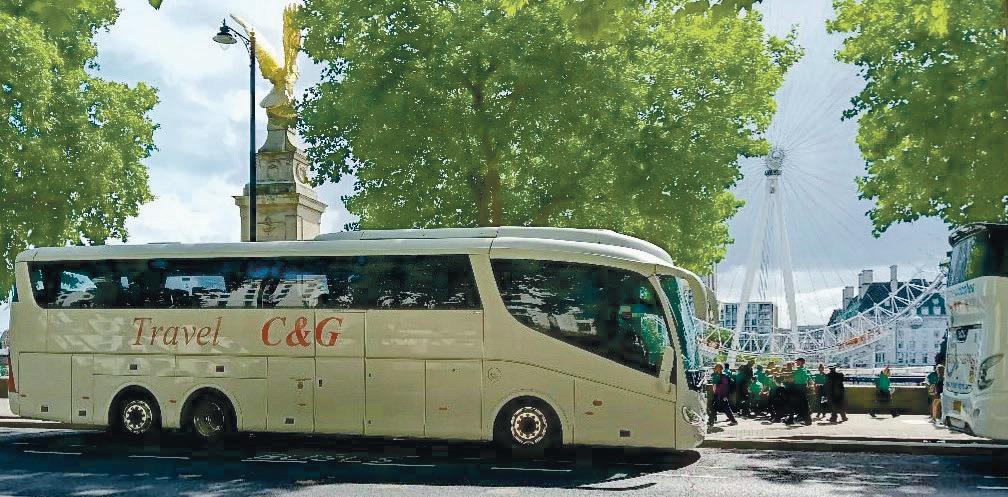 by matthew hipkin
by matthew hipkin
It’s Lent. If one sought an antidote to the wave of new–term optimism, they need look no further than the miserabilists-in-chief: he Smiths. Coincidentally, a Smiths’ tribute band is set to play at MASH (of all places) at the end of term.
his May will mark 40 years since he Smiths’ debut single, “Hand in Glove”. “Woe is me!”, Morrissey crooned with tongue irmly in cheek, lamenting the impending loss of his illusory sweetheart. Composed impromptu on a “crappy old acoustic guitar”, Stretford-bound down the M56, the rif dovetails elegantly with Morrissey’s trill.

Tracks like “Rubber Ring” and “How Soon Is Now?” warn against romanticising the future – a chronic folly of the average Cambridge student. To live in the now, after all, is to face the spectre of the Week One essay. he latter’s title seems to tease the would–be Lent term resolution maker. How soon will that Varsity article be written or May Ball committee joined?
As is tradition, I must state that I regret what he has become, lest my name be forever preserved in print as a vassal of House Morrissey. After all, praise of the song is not praise of the songwriter.
Our online store, ofering a range of Our online store, a range Varsity Varsitybranded items is open now! open
Pack of Pens: £2.39 Pack of Pens: £2.39 Pens: Pens:
Mugs: £4.99 £4.99
Facemasks: £5.79
Facemasks: £5.79 £5.79 £5.79
T T--Shirts: £13.49 Shirts: Shirts:
Sweatshirts: £17.99
Sweatshirts:
Backpacks: £9.99
Backpacks:
Tote Bags: £3.99
Tote Bags: £3.99 Tote £3.99 Tote £3.99
Music
▲ ILLUSTRATION BY FLO BROCKMAN
▲ PHOTO BY PAUL HUDSON/ FLICKR
PAUL HUDSON ▼
Postal print subscriptions are now available too Postal print are available too- get copies of copies of Varsitydelivered directly to your to your door worldwide! door worldwide! All items subject to availability. Above prices exclude postage Above prices exclude postage & packaging. All major credit and debit cards accepted packaging. major credit and debit cards
www.varsity.co.uk/shop 26 Vulture Friday 3rd February 2023
Shop Varsity!
Is it better down where it's wetter?
Georgie Atkinson asks the Cambridge University Yacht Club what tracks keep their heart rate up

Having got to know Julija Maldutytė through our shared passion for the Electronic DJ, Mall Grab, I couldn’t help but be intrigued by the role dance music played in another one of Julija’s pastimes: yacht racing. I sat down with the Commodore, Callum Henderson, and Julija Maldutyė, previously the Social and Welfare Oicer, of the Cambridge University Yacht Club, to talk about the connection between the nautical and the musical.
Attempting to come up with a novel way to interview Julija and Callum, I thought what better place to begin than with them reviewing nautical themed music lyrics to see how accurate they potentially were.
In response to TLC’s, “Don’t go chasing waterfalls, please stick to the rivers and lakes that you’re used to”, Julija noted that sailors do tend to prefer the open water and that the words of TLC were not particularly inspirational when it came to sailing. Callum echoed this and rather tongue-in-cheek noted that TLC may have been more inspired by canoeists than Yacht sailors.
Alex Turner in the Arctic Monkeys’ track, “One Point Perspective”, gave the world the remarkably niche lyric, “I swim with the economists”. Callum and Julija both noted that, whilst they have not necessarily swum with any economists, sailing does seem to attract more venture capitalists than economists.
Finally, I couldn’t not ask the duo about, as Sebastian in he Little Mermaid sings, whether it is indeed better, “down where it is wetter”. Happily, Julija took my childish questioning in good faith and highlighted that, “the whole point of sailing is to stay in the boat; rather than a man overboard”. Callum agreed, stating without irony that, “a man overboard is one of the worst things that could happen”.
Moving swiftly beyond the painful round of questioning, Julija commented that similar to the nature of the sea, the music played on the boat would completely change based on the elements around the boat. During Varsity racing, she noted that “Pump Up he Jam” naturally was played to get the racing crew “pumped up” accordingly. Whereas, when sailing blissfully around the Balearics in the summer, Balearic beats, Funk and Disco were far more appropriate. Callum conirmed that the nature of the music he played was completely dependent on the journey itself, expressed by his penchant for listening to Buena Vista Social Club whilst sailing around the tip of Italy. If you needed a University Club to provide an idyllic playlist, CUYC would be my irst port of call.
Callumis a Part I architect and, unsurprisingly
undertaken).
When the topic of sea shanties were broached, Callum noted that, on a recent voyage, a passenger had requested a sea shanty be played each day. However, he rather aptly noted that, if the passenger wanted a sea shanty played, they would have to sing it themselves. his perhaps rather aptly demonstrates that the taste of the CUYC is far more tasteful and vibrant than tracks such as AWOLINATION’s “Sail” would suggest.
given the nature of ARCSOC, noted a personal interest in traditional techno artists and producers. However, Callum went on to demonstrate an impressive knowledge when discussing the DJs Len Faki and Richie Hawtin. I couldn’t help but notice the intensity of the BPM of Hawtin's tracks — a BPM that perhaps matches the intensity of one's heart rate when ixing the failed engine of a yacht at 4am (a task Callum has previously
Video
killed the radio star
Aaron Syposz chats to Cam FM
Anna-Maria Woodrow, head of music at Cambridge’s student radio station Cam FM, admits that she didn’t listen to a huge amount of radio growing up. In an age of millions of songs ready to stream at the drop of a hat, that’s perhaps not much of a surprise — when there’s so much choice, it’s perhaps hard for the old-fashioned airwaves to compete. But what Anna-Maria has found in her time as head of music is that radio has something to ofer that streaming can’t — and that curating a playlist as a job can really be rather hard.
“here’s a spontaneous, ephemeral quality to radio,” she tells me. It’s a spontaneity which she inds strangely comforting: “when I’m looking over all my albums in Spotify, I can get a sense of fatigue. he radio, you can just turn it on and it’s there”. I get what she means — there’s something refreshing about being able to turn on Cam FM any time of the day and be met with curated music or some friendly voices. What’s more, there’s so much more character to a radio station than some random playlist, as custom-made stings and jingles break up the music as listeners go about their day. But what is it that a head of music actually does? Well, it turns out it can be quite a lot of work.
It’s Anna-Maria’s responsibility to manage the “playout”. his is the playlist that goes round by default when someone isn’t doing a live show on Cam FM from the studio. On one hand, the challenges are the same ones you would have if you were wanting to make a really long playlist. he playout can sometimes play for hours at a time between live shows, Anna-Maria needs to have hours upon hours’ worth of songs in her playlist. “I noticed at one point that the songs were looping after about two hours and that wasn’t good,” she confesses. Some considerations, though, are rather more unique to radio. Anna-Maria notes that the playout shapes the “background vibe” of the whole radio station — she has to make sure that this is appealing enough to keep people coming back for more.
Sticking to a musical vibe is familiar ground for Anna-Maria; on her own radio (Mondays at 11pm), she often sticks to a self-imposed theme such as “animals” or “the sea”. Indeed, one of the great strengths of Cam FM, she points out, is its huge array of specially themed music shows. She’s particularly enthusiastic , a show which ran last term specialising in country music, and , which has a focus on ambient jazz as well as presiding over all the weird and wonderful music across the airwaves.
Anna-Maria encourages everyone to get involved, saying a music show is an easy gateway into the world of radio. In an age of streaming, is there still a point to tuning onto the FM airwaves to ind music? he folks at Cam FM, Cambridge’s student radio station, certainly think there is.

Music
▲
PHOTO BY JULIJA MALDUTYTE
❝
TLC may have been more inspired by canoeists than Yacht sailors ❞
Vulture 27 Friday 3rd February 2023
PHOTO BY ANNA-MARIA WOODROW ▶
Communities, not careers, are are at the heart of amateur theatre
Behind the Curtain: Robinson's Pasek & Paul


Isabel Dempsey




Simultaneously one of the best and worst things about Cambridge is its overwhelming population of talented people – people such as dynamic theatre writing duo, Max Mason and Ben Cole. Both second-years at Robinson College, they’ve recently made waves in the Cambridge theatre scene with their joint threats of performing, directing, composing, and –most impressively – making musicals. Although the pair have now joined musical theatre forces, they started their journeys from very di erent places. English student Max grew up doing theatre. His love of literature led to a love of writing and, coming into Cambridge, he knew he “wanted to make a mark”.
On the other hand, while music student and organ scholar Ben “used to do quite a lot of theatre”, when it came to the question of what he wanted to do with his life, he “had to sacri ce it for music.” But, strangely enough it is this love of music that brought him back, as he started frequently accompanying people who sing musical theatre at university. He tells me that it was actually a conversation with his director of music from school that brought him back to the theatre world and “planted the idea of writing a musical”. at very seed grew into last term’s Cambridge University Musical eatre Society’s freshers’ musical: Field of Folk.
Coincidentally, while Robinson College Music Society president Ben was being pulled in the direction of theatre, Max was being pulled towards music after directing the opera Semele last term. He described the project as a “big step out of my comfort zone”. However, his background also helped him “treat it like a work of theatre rather than a work of music” and he worked hard to move it away from the inaccessible pretentiousness usually associated with the opera world. Combining theatre and music, the pair joke that through this genre their “di erent worlds have collided”.
Cambridge is often proclaimed as one of the best drama schools in the country, despite not actually o ering a course in drama. While partly a re ection on the huge names that the Cambridge theatre scene has produced, this should also be credited to the professional approach that students take towards their work. Many get stuck in with the theatre scene in Cambridge with this constant thought in the back of their minds: “Could I just do this for a living?”.
is will not be a shock to anyone who has been involved in a production or has had the misfortune of becoming an emotional support crutch to an overly stressed thesp. Scenes are rehearsed, sets built, lighting designed, music composed, and dresses run all in the space of a handful of weeks. ose who are regulars in the Cambridge theatre world typically have made peace with their degree being managed around the margins of an intense theatre schedule.
As such, the world of Cambridge theatre is one that favours the would-be professionals; those who constantly have a show in the works and are willing to go that extra mile for each production they are involved in. ey are the last to leave the ADC Bar, chatting to their friends of di ering year groups and colleges. Friendships formed in the furnace of whatever strange college room rehearsals take them to.
However, the drive of the Cambridge thesp to get that part, work on that show – epitomised by incredible opportunities like the Marlowe showcase – leads to them overlooking a crucial part of amateur theatre. For many, Cambridge theatre doesn’t have to be a pipeline to future greatness and they never wish it to be. Amateur theatre holds so much of its own value in communities throughout this country – especially nowadays.
With cost of living rising, and theatres struggling to recover from Covid, the escalating cost of professional theatre is making the formalised dramatic arts less accessible. Meanwhile in village halls, scout huts and cricket pavilions across the nation this Christmas, diasporas of amdram lovers engaged in one of the greatest of British traditions; the Community Pantomime. To those
who have not attended one of these occasions, you are missing out. My own village’s panto was essentially a compulsory part of the educational curriculum. Going back this year, I was reminded of the power of this tradition in community building.

ese productions are team-building exercises that would thrill any corporate HR team. Children, parents, pensioners alike spend months stitching costumes, painting scenery and writing bad knock-knock jokes to delight the toddlers. ese are carefully balanced against overcooked attempts at political satire to please the centrist dad (I’m sure Liz Truss got plenty of shoutouts this year). It’s amateur drama for its own sake; produced by the community for the community. is same attitude can be re ected in Cambridge theatre, when student drama is at its best. People brought together with a shared project that they are trying to pull o , in what often seems like the most ridiculous of timeframes, for their enjoyment and for the pleasure of the Cambridge student community. But too often, this value is lost in the aspiring professionalism of university theatre. Obsessive focus on labels such as “footlight” or “Marlowe performer” seem to be rooted in a desperation to be part of that Cambridge-industry pipeline. In this mentality, student amateur drama becomes nothing more than a stepping stone to bigger and better things after university.
I have nothing but admiration for those thesps; committed enough to their art to decide at this age that it will be the de ning part of their university experience, with the hope it will be their working life after university. But by framing the Cambridge theatre primarily as something reserved to be the “stomping ground” for the next generation of Phil Wangs and Tom Hiddlestons, the essence of amateur drama can be lost.
Amateur drama, especially at Cambridge, opens up so many opportunities beyond university, so by all means shoot for the stars. But remember: your bigger and better things might well be your own community pantomime, and what a privilege that would be.


With their paths of music and theatre now rmly crossed, Max gives me an insight into the pair’s creative process. He says they’ll usually “plot out a narrative and number of scenes and then I will sit and write the text of a song or scene and send it to Ben” to compose the music. However, before they could fully throw themselves into Field of Folk it had to be “put on the slow burner” for Max to direct A Midsummer Night’s Dream – their Easter term passion project. With Ben writing the music for the show, Max says: “Midsummer was a way of us learning to nd our feet in terms of creative collaboration.”
By the time they came to Field of Folk, this collaboration was certainly perfected. For those of you unfortunate enough to have missed the show, the musical is an “adaptation of the Medieval dream vision”, loosely inspired by the 14th-century poem ‘Piers Plowman’ by William Langland. Max tells me: “It’s a genre with huge imaginative capacity – there’s no limits to a dream”. ey were excited to bring it to a modern audience and give it a contemporary twist. Ben explains: “It’s a bit meta in that way. We have a dream to tell a story about a man who dreams”. And this dream certainly surpassed my wildest expectations. e soundtrack to this spectacular musical is now available on Spotify for anybody who wants to give Ben’s beautiful bops a listen.
When I ask about their future plans, Ben tells me that on the night of the get-out of Field of Folk, Max mentioned that he “had great idea for a musical about Martin Luther and the ’95 theses,” which promises to be “an hour of funny.” Max calls Martin Luther “the celebrity star of the Reformation” and the pair “wanted to do a satire of religion á la Mormon”. Ben says “a lot of good ideas immediately sprouted from that…but that would be a spoiler. Come and see it when it’s actually written”.
Looking even further in the future I ask the two second-years if this is something they’re interested in pursuing as a career, to which Ben interrupts with an immediate “yes”. Max tells me they see themselves “as individuals going into the eld, and as a pair we suit well as well”, as they start joking about the possibilities of “Mason, Cole and co”. Max describes how “a lesson can be drawn out of the way we work which is just ‘talk to your friends’, and there’s chances that your friends will have shared interests”. He refers to “creative collaborations” such as his and Ben’s as a “very precious thing”. And after having watched this talented pair spark o each other for almost an hour, it would be hard to disagree.
eatre
Jude Crawley nds the Cambridge theatre world is dominated by the desire to become a professional, diminishing the value of “amdram”
PHOTO BY ISABEL DEMPSEY ▶
28 Vulture friday 3rd february 2023
ILLUSTRATIONS BY ALEX PARNHAM-COPE ▲
BE INSPIRED by your surroundings
Designed by Sir Robert Smirke, the architect responsible for the British Museum, the Club’s impressive façade illuminates Pall Mall. Inside, a burgeoning social scene sees a host of diverse events take place each month, including Cocktail Making Masterclasses, Wine Tastings and Themed Dinners, as well as visits from highly distinguished speakers, including politicians, authors, ambassadors and academics. Members needing somewhere quieter can seek inspiration in the Club’s impressive library – home to nearly 20,000 volumes – or head to its dedicated business area.
For details on membership or a tour of the Club house, please visit www.oxfordandcambridgeclub.co.uk or call 020 7321 5103 Oxford and Cambridge Club @oandcclub
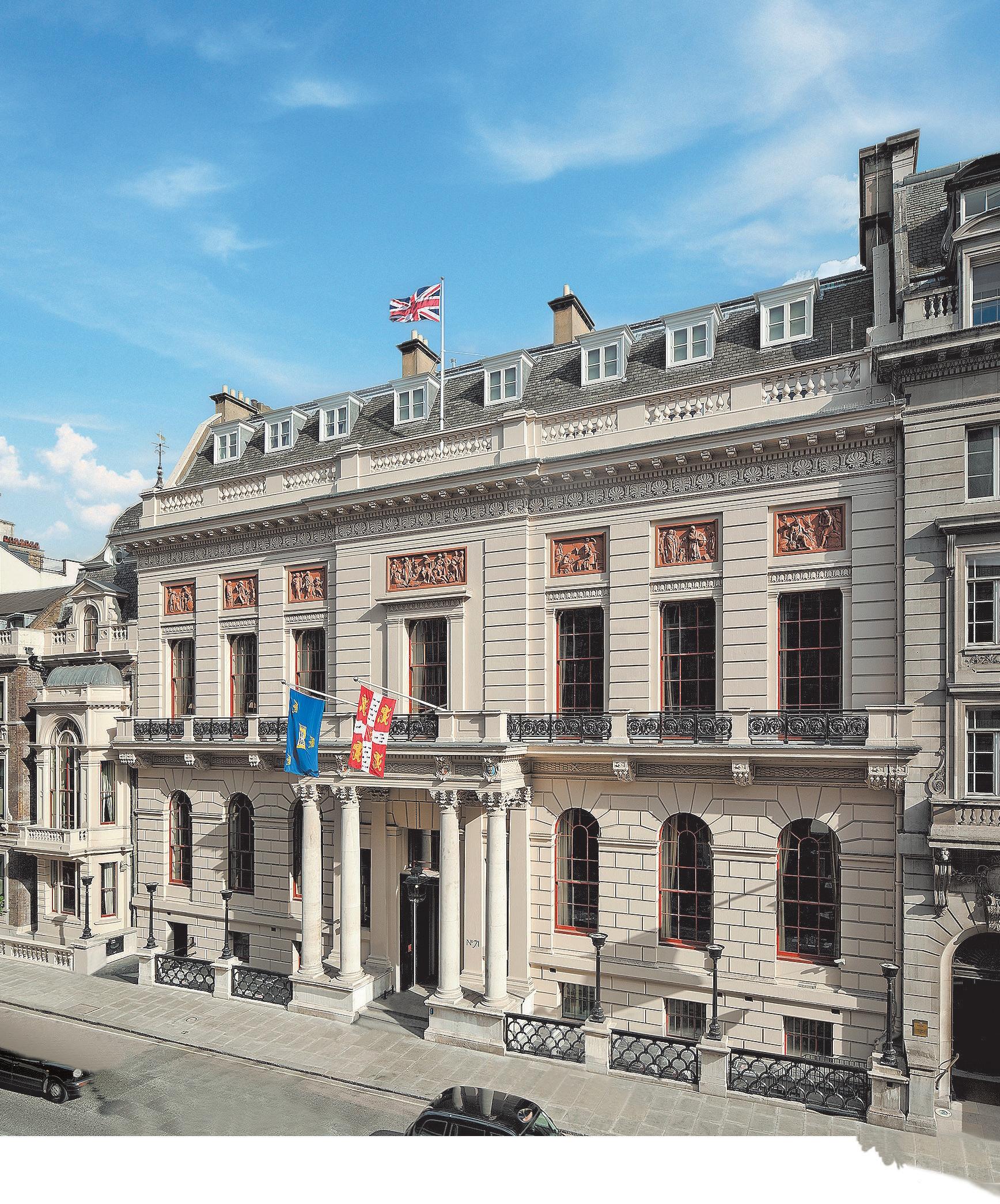
Week 1 Review Roundup
Varsity's theatre writers give you the low-down on the rst shows of Lent term



Addenbrooke’s Panto
e 30th Addenbrooke’s Charity Pantomime, Frozenmide: e I.C.E Queen, was another roaring success this year! A heartwarming insight into the bonds of community that form in the intense crucible of Medicine at Cambridge, and proof medics really can do it all.
CUMTS 24 Hour Musical







Results of a pressure cooker of creativity are a splendid watch in CUMTS’ 24 Hour Musical – funny lyrics, catchy melodies, and lovely singing make for a giddy 50 minutes of alcohol-fuelled fun.
Hamlet
Unconventional casting uncovers new nuances in the European ea-
tre Group’s unforgettable production of Hamlet, full of disturbing representations of madness and grief, strong performances, and gorgeous design work.
Scratch Me
○ Unreviewed
e wildly experimental twowoman team behind 52 Monologues for Young Transsexuals dig their nails into Scratch Me, a brilliant cabaret of comedy, dance, spoken word, and titillating provocation from Cambridge’s most daring dramatic duo.

Parlour Song
After the unforgettable success of Enron last Easter, Director Neve Kennedy proves her reputation for excellence with Parlour Song: a modern day Othello, completewith production value worthy of the West End and a performance by Bella Ridgwell as demolition expert Ned that, literally, brought the house down.
Cow
○ Unreviewed
In her tour-de-force confessional one-woman show, Cow, Evie Chandler covers a broad range of topics from her unique perspective: family, love, sex, therapy, Grindr, trans-ness, and much more are all addressed in this portrait of an artist emerging from her chrysalis.
Jailtime
Bringing together some of Cambridge’s funniest comedians, Jailtime: An Unlawful Sketch Show is packed full of brilliantly original sketch ideas. Unfortunately, it is a little overpacked...
Your Call
From the writer of Medea e Musical comes an original play Your Call where deeply human messages and strong performances struggle to
shine in an ambitious and daring production.
e Last Five Years
Ben Mulley and Juliette Ball stun both vocally and emotionally in this production of e Last Five Years: unraveling both sides of a couple’s journey from courtship to divorce through song and lovely staging.

Our favourite: A Midsummer Night’s Dream
e Marlowe Society’s distinctly modern production of A Midsummer Night’s Dream shimmers in its incandescent glow: a mosaic of colorful lights, eclectic choreography and a soundtrack of bangers takes this interpretation of Shakespeare's classic comedy to new heights.
So too do its bold performances bravura turns in unconvential dualroles by Joe Harrington ( eseus/Titania) and Temitope Idowu (Hippolyta/Oberon) anchor the production, with excellent chemistry amongst the rest of the cast buttressing Kitty Ford's brilliant chewing of scenery as Bottom adds buckets of laughs.

30 Friday 3rd February 2023 eatre
★★★★
★★★★
★★★★★
★★★★★
★★★★
★★★
★★★★
★★★★★
piqued? Read the
reviews at www.varsity.co.uk/theatre
Curiosity
full
▲PHOTO BY THEA MELTON
What's On?
by Daniel Hilton
3rd February 17th February
Music Nights out Arts eatre
PCCH state Cuppers credentials with hardfought win
Jonny Co ey
A hat-trick from Faye Lynch-Williams powered Peterhouse/Clare/Clare Hall (PCCH) to a 3-2 victory over Wolfson/ Darwin/St Edmund's (WDSE) this Saturday. Having gone 1-0 down, PCCH clawed their way back to secure a seminal spot in the womens and non-binary football cuppers.

e Yellows (PCCH) were deserved winners, recovering from a slow start to impose themselves on the game. Confronted by a gritty WDSE defence, the inventive attacking play of LynchWilliams and Louisa Henry proved decisive. Ahead of a semi nal clash with reigning champions Jesus, PCCH will take con dence from a gritty comeback victory.
WDSE claimed an early lead through Mia Hassoun, who slotted home coolly after the ball broke loose in the box. Remaining on the front foot, the Reds (WDSE) threatened to double their lead, firing narrowly over and wide
from two good chances.
With the game slipping away, PCCH kicked into gear. Showcasing their undying commitment to gegenpressing, the Yellows forced WDSE back, and began to dominate the ball, with Henry providing tempo from mid eld.
Despite strong team play, it was individual ingenuity that brought the equaliser. Lynch-Williams cut inside from the right wing, evading the challenges of two defenders before ring into the top right-hand corner.
Parity was almost short-lived, as
Weekly round up
Sear.
With the scores level at the break, it was all to play for in the second half. PCCH capitalised on a strong start, racing into a 2-1 lead. Latching onto an inch-perfect Henry through ball, Lynch-Williams claimed her second with a neat nish into the bottom-right corner.
A resurgent WDSE found an equaliser through an outstanding team goal. Having worked the ball through mideld, the Reds found space out wide. A teasing ball into the box found Mia Hassoun, who guided the ball into the
In a cagey conclusion to the game, Lynch-Williams was once again the di erence-maker. WDSE failed to clear a corner ball, and the PCCH winger pounced, beating the keeper from close range. Resilient defence maintained the lead, and PCCH celebrated a momentous win.
Varsity Player of the : Faye LynchWilliams
Abbie Hastie recaps football, rugby union, and netball
 ▶PHOTO BY THEA MELTON
▶PHOTO BY THEA MELTON
e women and non-binary football Cuppers reached the quarternal stage this weekend, and the growing depth of quality at college level was evident in some very close matches. On Saturday afternoon, Jesus came back from 2-0 down to beat the unfortunate Gedwards (Girton/Murray Edwards) 3-2, while PCCH (Peterhouse/Clare/ Clare Hall) beat WDSE (Wolfson/ Darwin/St Edmund’s) by the same scoreline. Elsewhere Newbroke (a combination of Newnham and Pembroke) picked o the dangerous John's/King's by 2 goals to nil, and Fitz/Corpus were awarded a walkover versus Trinity/Selwyn/ Robinson. e semi nals will see Jesus play PCCH and Fitz/Corpus play John's/King's. e weekend also saw the rst rugby union Cuppers xtures of the new term. Jesus were victorious again, to the delight of their hardy crowd of supporters, as they beat the mature and graduate colleges’ All Greys 28-21 to progress to the second round. In an early second round xture, Pirton (Pembroke/ Girton) thrashed a beleaguered, understrength and tiring Queens’ side 34-5 to send a message to their competitors.
was joy for CUAFC in the league and the cup as both the
women’s Blues and men’s Falcons (2nds) won on Wednesday afternoon. e Falcons, despite the absence of their captain Joe Helm, beat Leicester 5-0 to keep the pressure on at the top of the table. Meanwhile, the women’s Blues made the long trip to Southampton to face Solent in the BUCS National Cup second round. ey dominated the game, but individual lapses of concentration meant that Solent were able to take the lead and then respond to two beautifully worked Lucy Fell goals. Penalties ensued, and the Blues attempted to lay to rest the ghosts of last year’s gut-wrenching Varsity defeat. All ve Cambridge penalty-takers scored, which meant an early save from goalkeeper Emilia Keavney was enough for victory and the quarter nals.
CULNC were also in action at the Sports Centre on Wednesday afternoon. e Jays (2nds) also laid a marker down for their upcoming Varsity match by beating Lincoln 1s by 50-28. eir win showed resilience, as they saw o a slight resurgence from Lincoln in the last quarter, prompted in part by the substitution of many of their senior players. Victory should help them stave o relegation, as they battle to avoid the drop in a tough season.
Friday 3rd February 2023 31
Sport
ere
04 February From Darkness to LightCUCC, Collegium Musicum John's Chapel, 8:00pm 12 February Temor + DJTRIO Clare Cellars, 8:30pm 13 February Fitz Swing Valentines Concert Fitzwilliam, 7:30pm 17 February Cheap Date + Manilla Times e Portland Arms, 7:30pm 03 February Cambridge Charity Fashion Show Launch Party Hidden Rooms, 8:30pm 03 February Transmission Electro Night 2648 Cambridge, 9:00pm 04 February Dot Cotton Club Rainbow Party e Orator, 9:00pm 11 February JAMnesty e Portland Arms, 8:00pm 07 – 11 February Sunday in the Park with George ADC eatre, 7:45pm 07 – 11 February My Mother Said I Never Should Corpus Playroom, 7pm 08 – 11 February Playing Pretend Corpus Playroom, 9:30pm 14 – 18 February e Hollow ADC eatre, 7:45pm
03 February Painting & Prosecco Station Tavern, 7:30pm 08 February JazzSoc x Blackbirds Poetry Jam / Jazz Slam Hidden Rooms, 8:00pm 11 February Cambridge's Craft & Flea St Paul's Church, 11:00am5:00pm 15 February Glasshouse Adventure - at night! Cambridege University Botanic Gardens, 4:30 - 8:00pm
WDSE threatened the PCCH goal once more. A counter-attack sent the Reds’ striker through on goal, only to be denied by an outstanding save from Lily defence
maintained Match
Sport
e
Jacob Tucker
In trying to get a place at a reputable university after A-levels, students nd themselves trying to collect UCAS points. Five A*s equals 280 points; three Es are only 48. As a purely academic measurement this seems fair: get higher grades, take a risk and opt in for more courses, and it might pay o . However, this system becomes quite exploitative when extracurricular activities are also taken into account. Playing an instrument can land you up to 30 more points – more than an additional AS-level. A quali cation in horse riding is considered equivalent to a C. Even volunteering can be used for points.
It’s all rather cynical. A lot of teenagers up and down the country have no doubt taken on skills they don’t care about for the sake of collecting a few more imaginary points. A pessimist might say that even something as cherished as DofE has been reduced to some sort of greedy ruse to keep Go Outdoors in business. Personal statements are yet another quanti able template in a sea of judgement by which the “objective” value of a teenager can be scored.
But, if Cambridge doesn’t care about
UCAS, and is thinking of scrapping personal statements, then what relevance could these systems hold here? What on earth does this have to do with sport?
e Cambridge Blues system for sports has a far longer history than something as pithy as UCAS. e rst game between Cambridge and Oxford, the rivalry which ultimately led to the Blue and Half-Blue becoming tangible achievements, was organised by Wordsworth’s nephew in 1829. It’s traditional, some might say. It’s beyond rebuke. To an extent, this is true. As a tradition, the system is interesting and iconic, and it is a valuable achievement, too. To have both a degree and a full-Blue from Cambridge is a pretty remarkable achievement. You’re well-rounded. You’re probably more interesting than the average person. You can make jokes about it and visit special clubhouses.
e problem with this system is not a result of tradition or iconography. ese are the bene ts. e issues arise when achieving an award in sport becomes yet another mark of di erentiation.
Academic in ation is a more pressing issue than most students like to admit. More and more people are attaining degrees, which therefore decrease in social
PCCH march on to Cuppers semis Page 31
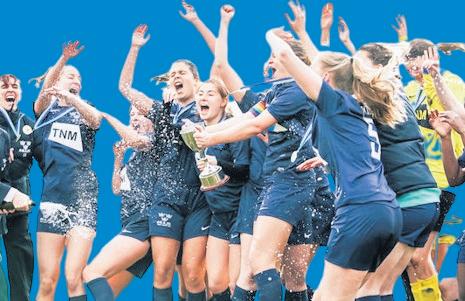



Rugby Union cuppers kicks
value. So, more people go on to do a master’s. e same thing happens. And then again with PhDs. Nowadays, we specialise in order to stand out, not out of necessity, or because of a genuine love for our eld. You get a place at Cambridge. Well done, but you’re not quite special enough yet. e marketplace for your subject is likely extremely competitive: the “Cambridge” brand name will help, but it might not be enough. You’re on track for a First. Still might not be enough. So, where can you turn?
is is the problem with the system of Blues. ey do represent something important. ey’re a piece of

ey’re something for anyone with a genuine interest in sport to strive for. However, to think of this prestigious award as simply another collectible accomplishment is disingenuous. We’re all grownups here. We shouldn’t need to rack up imaginary points to satiate our egos.
Don’t play tennis, run, or play football for the sake of your future employer. If that’s really something a law rm or publishing company or tech corporation feels strongly about, they’re likely faking it just as much as you are. Get involved with sport because you love it. ere’s no better reason.
Hillsborough: Football, class and the authorities

Jesus scored a last minute winner to beat Girton/Medwards (“Gedwards”) 3-2 in the quarter- nals of the Women’s and Non-Binary Cuppers Football on Saturday afternoon.

If you follow the tram tracks in Hillsborough, near where I live in She eld, you’ll nd yourself standing by a memorial. It’s small, blink-and-you’llmiss-it against the towering backdrop of the Hillsborough Stadium where She eld Wednesday regularly play (and lose), but it’s in perfect condition, well-kept and always covered in owers. She eld still bears the scars of the tragedy all these years on, even though the primary victims of the disaster were from Liverpool and Merseyside. In some ways, it makes sense that we still carry this guilt. It happened on our turf and it was our police force that let it happen.
As the police nally apologise for their role in the Hillsborough disaster, Emily Lawson-Todd asks why it took so long families, promising “cultural change”, comes 34 years too late. For the past 34 years, countless communities, families and individuals have been embroiled in torment, consistently denied justice at the hands of several inquiries and prosecutions that went nowhere, while the perpetrators and instigators of the tragedy walked free aside from a mild slap on the wrist. In fact, the length of time that it has taken the police to apologise is almost double that of Steven Gerrard’s professional career, which was inspired by the death of his cousin in the disaster. While it could be fair enough to just stay here and express shock and anger at how o ensively overdue this apology is, the question arises: why did it take so long to say sorry?
e recent news that the police have released an o cial apology to the 97 victims of the disaster and their
e tragedy that occurred on 15 April 1989 was overwhelmingly due to police negligence. From the o cers’ lack of acquaintance with the grounds of Hillsborough Stadium, to the poor marshalling of 24,256 Liverpool supporters dependent upon them for their safety, there was a failure to adhere to safety standards at every level. Gate C on Leppings Lane, the site of the disaster, was
opened prematurely, causing a lethal bottleneck. ough the opening of the gate was revealed to be the decision of former South Yorkshire police chief superintendent David Ducken eld, this was only admitted in 2015 during a trial concerning the events. Previously, Ducken eld had instead adopted the lie that the gates were forced open by rowdy and intoxicated fans. In reality, the bins outside the stadium were not so much lled with cans of beer as they were with Vimto and Coke.
e fact that Ducken eld’s lie was allowed to ourish largely unchallenged, casting the blame for a tragedy as unspeakably horri c as Hillsborough onto the victims and their families, exposes an uneasy relationship between class, sport, and the authorities. e police were all too ready to fall on old tropes of “football hooliganism” in order to protect their necks and wash their hands of blood because they knew that it would work; that the public would be ready to accept that the fans were simply mindlessly violent and unruly. While the term “hooligan” gets volleyed at most sports fans, it seems to nd itself most commonly attached to sports that draw in more working-class fans such as football. While I am not trying to diminish the fact that football fans can behave violently or
disrespectfully, it seems strange that only football fans seem to get ak over their actions. Nobody ever talks about the “hooligan” actions at the races, despite them being boozy, often raucous events. e same goes for rugby union. As a Cambridge student, I have been an unfortunate witness to drinking-soctie-wearing, rugby-union-playing private school lads’ actions in my college bar which have been on par with, if not worse, than the aftermath of any Shefeld Wednesday loss. Unfortunately, it appears that unruly behaviour in spectator sports is yet another example of “one rule for us, another for them” that ultimately allows for the blame to be shifted away from the authorities onto the people they have a duty to protect. e fact remains that this was an avoidable tragedy that should never have happened. e fans killed that day were not just a faceless mob, a homogenous entity, or even the ctional stock image of the football “hooligan”. ey were brothers, sisters, parents, children, friends and co-workers. Yet, more importantly, they were people who deserved more than they got. In life and in death they were denied dignity and let down by the very systems meant to keep them safe.
Last year’s champions Jesus started the match on top, largely due to excellent mid eld play by Anna Herr, who supplied striker Kaya Hardie with aplomb. ey couldn’t make this pressure tell though, and it was lowly Gedwards who struck the rst blow. Blues winger Tasha ornton-Clark incisively found her CUAFC teammate Tessa Doubleday who kept the ball alive, laying it o to nascent-mid elder Megan Clarke. She was almost immediately called into defensive action, clearing a Jesus corner before sending her team up eld. ornton-Clarke turned the Jesus leftback inside-out, before crossing to Doubleday again, who nished astutely to double Gedwards’ lead.
is goal roused the Jesus supporters who, unused to their team staring down the barrel of defeat, encouraged them to make their strength count in mideld and behind Gedwards’ backline. ere were signs of increasing Jesus penetration, despite Clarke’s commitment to covering every blade of grass. Herr found Hardie with a well-weighted through ball just before half time, and she converted to raise Jesus’ hopes of a comeback. Unsubstantiated rumours that the goal was “miles o ” did little to raise Gedwards’ morale.
In the second half, Jesus continued to have the bulk of possession and rode out multiple Gedwards attacks down both wings. Nevertheless, Gedwards’ defence was resolute, repudiating attack after Jesus attack. Eventually the pressure told, and seven minutes from the end Jesus equalised through Hardie, who latched onto a Beattie Green through ball after a slip by the Gedwards centre-back.
Jesus’ victory was not preordained though. Both ornton-Clarke and Doubleday had chances to win the match for Gedwards, but were denied by the keeper and the ultimate cruelty of a scu ed shot. is left the way open for Anna Herr to pop up at the death and sweep home into the far corner from the edge of the box Varsity POTM: Megan Clarke (Gedwards)
32 Friday 3rd February 2023
Emily Lawson-Todd
Abbie Hastie
‘Feeling Blue’:
downsides of Cambridge’s sporting scene Jesus resurrection sends them to Cuppers heaven
▼Katie SmithforVarsity
o ▲











 Senior News Editor
Senior News Editor































 Amelia Platt News correspondent
Amelia Platt News correspondent





































































 Chris Patel
Chris Patel





 Toby Smallcombe
Toby Smallcombe









 omas Idris Marquand and Suchir Salhan
omas Idris Marquand and Suchir Salhan





























































































































 by matthew hipkin
by matthew hipkin
















 ▶PHOTO BY THEA MELTON
▶PHOTO BY THEA MELTON






